Good news from over the hill - the first truffles of the 2007 Canterbury truffle season are being harvested. Nothing at Limestone Hills yet (but we're looking). It's an early start - last year fully ripe truffles didn't appear until the end of June, so there must be something in the cool spring/summer and dry warm autumn we've had. I won't mention climate change. Harvest is also under way in Western Australia, where Nick Malajczuk is expecting to get upwards of 400kg this year. WA is also planning its first truffle festival - 1-5 August at Mundaring. Copies of The Truffle Book will be available... And if you want to read more, the current of issue of NZ Geographic features an article of mine on truffles (follow that link to see an excellent truffle dive executed by Gavin, the trufficulteur from over the hill). The next will include one on climate change.
Truffles & Farm
A great article marked the reappearance of the New York Times De Gustibus column in the middle of May. Chef Daniel Patterson of Coi in San Francisco enumerated some of the shortcomings of truffle oil:
“I used to use white truffle oil a lot, but now I only use a little bit in my liquid black truffle ravioli,” Grant Achatz of Alinea in Chicago told me. “It adds a little more perfume, a slightly different flavor. I cut my teeth cooking at the French Laundry, and when we were using truffles there was always a bottle close by. But after I was on my own for a while I started to ask myself why I was using it, and I didn’t have a good answer. It doesn’t even taste like truffle.”
It might be OK for a molecular cuisinier like Achatz to play with truffle oil for nefarious creative purposes, but I think it's frankly scandalous that somewhere like the French Laundry would even think about inflicting the stuff on its patrons. They should be doing this:
...Mr. Palladin was enraged to walk into the kitchen and find that in his absence bottles of truffle oil had cropped up everywhere. Grabbing two of them, he called the staff out to the alley behind the restaurant where the garbage was held. He hurled the oil at the side of the building, smashing the glass bottles against the wall. “It’s full of chemicals,” he screamed at his confused and frightened staff members, who scrambled back to the kitchen through the gathering scent of truffle oil mingled with the fetid air of the alley. “No more!”
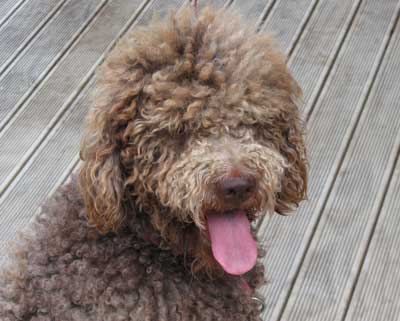
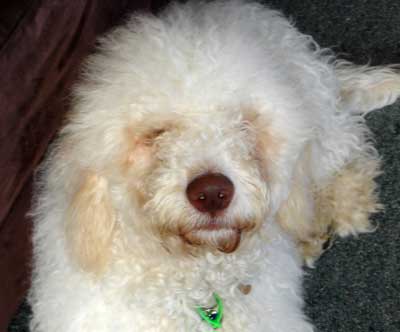
Freya (top) and Marcello - romance is in the air
Hot news in truffle dog circles - New Zealand's first lagotti are getting it on. Puppies will be on the way at the end of the year, if all goes well. Marcello was NZ's first lagotto, brought over from Australia in December 2005 by Robert and Cheryl Rangi, and Australian Ch Greydove Bella Mia Freya was shipped in at the end of last year by Sue Milner of Northland. Can I resist ordering one? Can I be "disloyal to beagles", as Camille puts it?
Meanwhile, the wonders of the interweb tubes brought me an email from the new president of the new Lagotto Club of America, Judith Martin, of LagottoAZ. She's training her dogs with truffles from the estimable Jim Wells of Oregon. Now, Jim and a lagotto? Good combination...

Pinot noir at Limestone Hills, May 5th, 2007
Danny estimated our first vendange to be about 35kg. Not a lot - barely worth picking - but it will be made into wine chez Schuster. Two main problems: the nets went on late, allowing the birds to get in and feast on most of what was there (which wasn't much anyway, because the region had a poor fruit set in our cold spring), and recent rain caused some fruit to split and pick up a fungal infection. Looking good for next year though. Nets on by the end of January, a bit of drainage work, and 2008 pinot and syrah from Limestone Hills should be a reality. Look out for Cotes du Waipara in 2009.
I haven't been to Chicago for 20 years, and I was younger then, happy to spend all night in a blues club getting over jetlag. At the IACP conference last week, I was more concerned with surviving to get to my workshop, resisting the blandishments of food and wine to arrive unscathed at the right room at the right time. I failed. Count the meal at Le Bouchon, preceded as it was by regular infusions of Peregrine Pinots gris and noir, and rounded off with a pleasant little Bourgogne, as my downfall. The company was excellent: Birgitta Watz, Annabel Langbein, my co-presenter Danièle Mazet-Delpeuch (the ch is silent) - former personal cook to President Mitterand - and the food was high quality French bistro-style. Danièle ordered the boudin noir, and pronounced that it was in the style of Guadelope or Martinique. It may have been made in San Francisco, but the man who made it came from the French empire.
Danièle was in charge of the tasting. We had very fine Oregon white and black truffles compounded specially for the occasion by Jim Wells of Oregon Wild Edibles, the white butter served on bread, the black on pasta. For comparison, we had some commercial "truffle" butter, which had all the finesse of truffled aftershave. Danièle - who is formidable in both French and English senses of the word - took the lead with the culinary history of the black truffle, and I finished off with a quick tour of the truffles of the world, and the iniquities of the overuse of truffle oil. Seemed to go down well...
But the highlight was not the workshop, it was the duck-fat fries at Hot Doug's, home of the best dogs in the mid-west. As the T-shirt there has it: "There are no two finer words in the English language than encased meats", and Doug may be right. But not with his Port Wine and Confit Duck Sausage with Black Truffle Butter and Chimay Cheese, which had all the hallmarks of truffle oil overuse. If a swiftly passing hot dog smells like cartoon truffle, you know you've made the right choice with the Portugese Linguica with Saffron Rouille and 12-month Manchego Cheese.
You can't keep a good Canuck down, not if they're intent on growing truffles in British Columbia. The Vancouver Sun has a nice piece about the fledgling industry (though I wouldn't trust all the "trivia" at the end).
"The Wynes planted 150 inoculated hazelnut trees two years ago and expect to have Perigord truffles in about three years. Like a pregnant woman, the trees are tested along the way. "They were tested at the molecular level to confirm the DNA on the root system was right. It's all in a concerted effort to make sure the industry has a high standard, right from the outset," says Quentin Wyne. He describes the allure and aroma of the Perigord as "somewhat garlicky, somewhat like the smell of freshly burnt soil after rainfall." Others, he says, have different impressions. "You wouldn't want to print those," he says, clamming up."
He's been reading the book. I'll have to introduce the BC crew to Michael Ableman, the US organic pioneer who is now farming in BC. He was a presenter at the IACP conference in Chicago, and we didn't quite get to exchange books - though I do know he's interested in truffles.
Australia's an amazing place. Big, old and flat, with a propensity for truffles, and native species well-adapted to sniffing them out, as the The Canberra Times reports:
"Truffles? Yes, these pointy-nosed forest foragers are Australia's truffle hounds, with a taste for some 60 species of native truffles that can be soft or hard-bodied and range in size from a golf ball to a pea. "You could call them truffle junkies or truffle gourmands. I've seen areas where fungi was fruiting that were so extensively dug over that it could only be called frenzied activity," Claridge says. Australia has between 500 and 1000 bush truffles, some with fragrant odours like garlic, vanilla or cinnamon. Others exude a pungent whiff of "rotting fish or diesel fumes". Potoroos and bandicoots are "basically a nose on legs" and seem to be able to sniff out truffle sites from some distance, Claridge says.
I'll settle for mice, and I can report that they are greatly reduced in numbers this year.
Everyone knows something about truffles, and often it's pigs. Truffles and pigs go together like a horse and... a 2CV. Pigs like truffles. But you don't find many people using them for truffle hunting, unless you're in the Périgord and the TV cameras are nearby. Chez Pim has a lovely post and some nice pictures of Marthe Delon and her pig Kiki. Pim's also done a very nice little truffe noir (as in film noir) piece about the truffe blanche d'Italie... Well worth checking out.
I had a very pleasant chat about truffles with Chris Whitta on Radio New Zealand National's Nights programme last night. For the next week you can stream the interview from the Nights page on the RNZ web site, or there's a podcast here (9.3MB). If you want to hear my dulcet tones, you'll need to click on one of those links before April 12th.
It's been a long time, as Led Zeppelin said (a long time ago), but I hadn't quite realised how long until tonight. Since posting about about the Oregon Truffle Festival, I've finished the first draft of my next book (details as soon as announcements are made to the trade), started working on it with my editor, got half way through a piece on the world of truffles for New Zealand Geographic, and thought a fair bit about what I'm going to say about truffles when I do my session with Annabel Langbein at the International Association of Culinary Professionals conference (see WS-29) in Chicago after Easter. Out in the truffiere the weeds are back under control, mouse poison has been laid in bright yellow bait stations, and the amazingly charming Peg is starting her pre-season refresher course.
There have been a few odds and sods of truffle news, but I'll catch up on that when I get back from Chicago. I wonder if Kingston Mines is still the best blues club in town?
As soon as I'd finished my keynote presentation, I relaxed and started to really enjoy the Oregon Truffle Festival. Talking to a room full of people and trying to keep their interest is a challenge at the best of times - to do it while talking about truffles doubly so. Mind you, I am known for volubility on the subject, and for the possession of definite opinions, so perhaps I have a slight advantage. As it was, I ran out of time long before I ran out of things to say - which will come as little surprise to my family. Fortunately, the things I said found favour with disparate sections of the audience - from the truffle gatherers of the Oregon woods, to the new truffle growers of the USA - even one imposing truffle importer (all 7ft and 250lbs of him). I talked about dogs mostly, and Peg was the star. Dogs are important to truffle growers because they are the first stage of quality control. And they need QC in Oregon, where the native truffles are harvested with rakes.
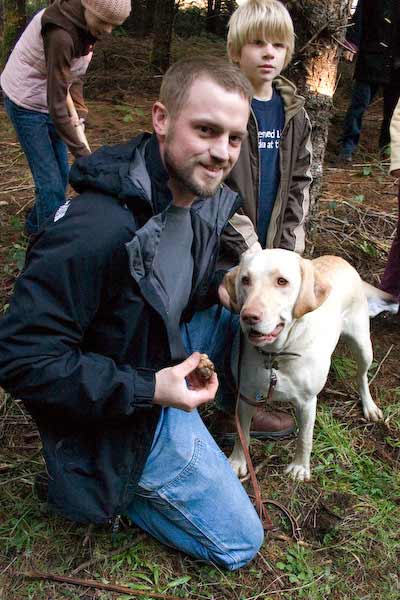
I predict this dog - Stella - will be the USA's first national truffle dog champion. Seen here with her owner, Aaron Kennel at the Festival foray at Shirewood Farm (where you can try your own hand at truffle hunting), she had just flown back from Tennessee where she'd found 9lbs of Perigord black truffle at a young plantation. A talented animal - and a keen owner with his own black truffle plantation coming along nicely.
I was inducted into the mysteries of Oregon truffles by Jim Wells, a man who is virtually single-handedly trying to impose quality control on truffles harvested by rakes. Bags of truffles arrive and Jim sorts them into grades. Some he can sell straight away, others can be matured for a while in paper bags in the fridge to develop full flavours - but only if they're showing signs of ripeness. Many are infants ripped from the womb, and will never mature.
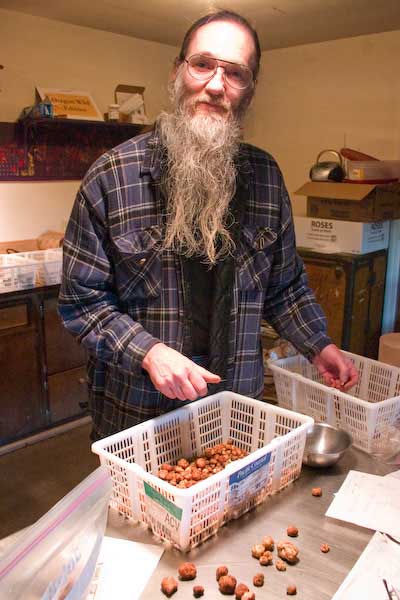
This is Jim, grading white truffles in advance of the Festival. He's not quite as imposing as Todd Spanier, the truffle importer, but waking between the two after the keynote I felt a lot like a hobbit in the company of men. Though my feet aren't hairy.
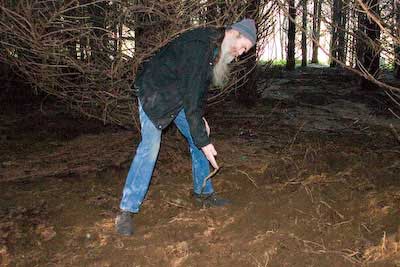
Jim also took me out to what used to be the most productive truffle forest in the state - called Kitty's Place. News of the good hauls to be had here spread through the rakers, and it has now been devastated by hyperactive harvestersr - probably speeding on copious quantities of crystal meth. Roots are ripped up and left bare, the soil left in loose piles. And they wonder why yields are dropping. If it's not criminal, it ought to be. A classic example of the tragedy of the commons - he who rakes first takes all, even if it's not ripe and ruins next year's harvest.
Harvesting with dogs is the answer, but how to transition the business to harvesting that way is a question impossible to answer. Meanwhile, Jim imposes his own quality standards. He sells Oregon truffles for twice the price that anyone else gets, and has customers queuing up for more.
The Festival itself was a great mixture of fine food and interesting events. I managed to eat Oregon white and black truffles, my first ever bianchetto (fantastic - I want my trees to produce today), Perigord black truffles, and to have a sniff of an incredibly rare Choiromyces species. I learned how to rake for Oregon truffles...
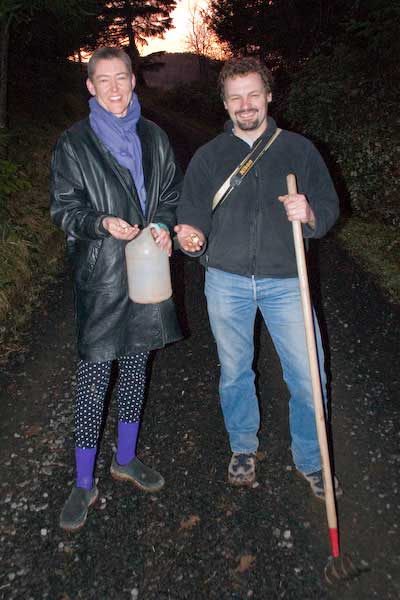
Lorraine and Charlie show off the spoils
...met the matsutake king of the Pacific Northwest, had a fantastic prawn pathia at what is without doubt the world's only Greek Indian restaurant, and sold all the books I had with me in the first 45 minutes of Sunday's marketplace. My thanks to Charlie and Leslie and the organisers and volunteers who made the festival weekend so memorable. I look forward to returning, and eating much more truffle.
And so I'm back in New Zealand after a fascinating 10 days in Oregon and California. I shall be blogging about the trip in due course, but the next book has to take priority - and the farm work doesn't go away. There are mice to kill... In the meantime, I've just posted the final part of my analysis of Ken Ring's forecasts for 2006. Shorter result: don't buy into his belief.
I don't think I've ever won a proper award for my writing. I did win the Printing World award for the worst headline of the Royal Wedding (Charles, well known Truffle Book fan, to Diana): a story about a particularly awful Royal Wedding money box gained the title Saving Up For A Reigny Di. So the news that The Truffle Book had won a Special Jury Award in the Gourmand World Cookbook Awards was a most excellent Christmas present. In order to collect my award, and to see if I've won any more, I have to head off to Beijing in April for the awards ceremony. Being a one man and a (truffle) dog company, that's a challenge - but one that may be met by raiding my wife's extensive airpoints stash. I'll be in good company - Julie Biuso is also headed to Beijing, and Annabel Langbein won an award last year. The organisers are also threatening to make the Awards dinner a "truffle summit" with luminaries like Edouard Loubet from la belle France. And me.
I won't let it go to my already large head.
The Independent reports on French truffle growers' attempts to secure a subsidy for their business:
Producers of one of the most expensive foods on earth, the truffle, are campaigning for a European Union subsidy. [...] Brussels has turned up its nose at the request, which it says does not "fit" its attempts to cut back on agricultural spending. The French federation of truffle producers says it will continue its campaign in the European Parliament. The problem, it says, is not truffle prices, which are booming, but the quantities of truffles found in Europe - mostly France and Italy - which are plummeting. Dry, hot summers, the advance of the suburbs and the use of agricultural chemicals are all blamed for the growing scarcity of the Tuber melanosporum, or "black" Périgord truffle.
Declining European production could be seen as good news for Southern Hemisphere growers, but I don't see it that way. We're not competing with each other - we should be cooperating to grow the world market - establishing year round demand for premium fresh product, rather than letting chefs get away with using artificial oils and "aromes". Much more worrying for me is the last sentence of the piece:
About 10,000 people in France are engaged in the truffle industry, mostly in the south-east. But only a few dozen make their living entirely from truffles.
I hope we can do better down here.
The Seattle Times is getting all enthusiastic about Oregon truffles, and it has to be said, so am I. I'm flying over to Eugene in a couple of weeks to give the keynote address at the Oregon Truffle Festival, and I'm really looking forward to getting my first taste of these truffles. Tyrone Beaston (rather breathlessly) explains the attraction:
The moment I heard chef and truffle-worshipper Kevin Blaylock yell, "Holy crap, I found a really big one!" as he scanned the fluffy, upturned soil in a patch of Douglas firs south of Olympia, I knew he'd hit pay dirt. He knelt and picked up a dingy white orb about the size of a gumball, brought it to his nose and took a whiff so deep and passionate I thought he was falling in love with it. From an aesthetic point of view, the ugly little truffle seemed hardly worth all the excitement. But truffles are surely the only fungus that can make a foodie drop to his knees in such pure joy. In this case, it was an Oregon white truffle, the lesser-known cousin of the famous and obscenely expensive Italian variety that many people encounter as aromatic shavings atop a serving of risotto or the mysterious musk in a gourmet omelet.
Charles Lefevre (OTF organiser, and no stranger to this blog) gives good quote:
I asked Charles Lefevre of Eugene, Ore., a Ph.D. in mycology and owner of New World Truffieres, which sells oak and hazelnut trees inoculated with truffle spores, to tell me how he's heard Italian white truffles described. "One description was goat piss, which I think is pretty close," he said. "Another was dead mouse trapped in a wall. The kinder description is garlicky. "The typical response when people smell Italian white truffles is, 'Get that thing away from me,' " Lefevre said. "It's a foul aroma, a nasty aroma — and some people just absolutely love it. And I'm one of them." Blaylock is one of those people, too. The 27-year-old swears he's so attuned to truffle scent, he can smell it in the forest air during peak season. When he handed me a couple of young white truffles to sniff during our Saturday morning foray, their funky, beguiling odor overwhelmed my senses for a second. The smell was both alluring and repulsive.
Goat's piss does not spring to mind when I consider the aroma of white truffles, but I can see where he's coming from with the dead mice. Charles claims that he was misquoted, pointing the finger at Dr Mike Amaranthus for the goat angle, but sticks by the dead mice. I shall test it out when I start on the muricide. Soon...
More OTF salivating here (but fewer choice quotes).
Christmas is rushing up, as are various deadlines (including one for the next book), but this item from the Washington Post is worth a read. It describes the rounds of a French truffle inspector - an official charged with ensuring that what's being sold as Tuber melanosporum is the real thing, and not Chinese (or anything else). It also includes some interesting information on recent French harvests - badly hit by heat and drought.
"Shrinking supply is also driving up prices. Over the past four seasons, truffle production in Provence has plummeted 70 percent, from 33,000 pounds harvested in the winter of 2002 to 9,680 pounds last year, according to ministry records. Truffle production nationwide last year was about 74,000 pounds, half the yields of a decade ago. Neighboring Italy and Spain also report diminished truffle yields because of dry weather. The harvests are decreasing dramatically," said Michel Courvoisier, who heads the French Federation of Truffle Producers. It's mostly due to climate changes. We've had recurring droughts in the past five years, which had a terrible effect on truffles."
Meanwhile, retailers seem keen to get hold of whatever truffle is available:
"Valayer bent over a mound of dirt-covered truffles that ranged in size from walnuts to softballs. He separated the specimens gnawed by rats, softened by fly larvae, munched by caterpillars or waterlogged by wet ground. He cut away the damaged sections and tossed the salvaged chips into a bin for canning. A half-ounce container of such leftovers was selling for $30 last week at Fauchon, the fancy Paris-based food emporium."
Spare me the rats. I have quite enough mice as it is.
Interesting insight on selling truffles to restaurants in New York, from the New York Times (registration may be required):
"Mr. Magazino opened a plastic foam cooler and pulled out the truffles, which had been sorted by size. The smallest, called first choice, range from the size of chestnuts to the size of plums. The medium-size “extras” can be as large as a tangerine, and the big-daddy “supers” can be as big as a baby’s head, though that day they were closer to an avocado’s dimensions. Mr. Magazino handed a cooler of caviar to his intern, Alex Zambelli, then grabbed the $30,000 worth of truffles, along with a stainless steel kitchen scale, and lugged them into the kitchen. (Rule No. 1: never take your eyes off the truffles.) Like most chefs, Shea Gallante reached right for the supers, fondling and sniffing each one. “The bigger ones aren’t any better than the smaller guys in terms of aroma or taste, but they make a better presentation in the dining room,” Mr. Magazino explained, inhaling the musky, funky, earthy, pungently cheesy scent of an extra that had the shape of a fingerling."
Give me a baby's head any day. Reminds me of some sage advice - "never eat anything larger than your head". And I never have...
There's a tradition, born of the marketing skills of Giacomo Morra, the man who put Alba on the map, of using the large white truffles that are found in most seasons to promote the business. The latest technique is to hold an international charity auction, with people bidding from around the world - and very effective it is. This year's 1.5kg monster sold for 125,000 Euro to Gordon Wu, a Hong Kong property developer, who plans to use it all at one banquet this week. At least he won't let it rot, as one poor London restaurateur did a few years ago...
A love of Italian white truffle is facilitated by extreme wealth, as the Daily Mail discovered when it reported on a £25 white truffle ice-cream served at Luciano (review) in St James, London.
The dish was created for the London based Russian billionaire Boris Berezovsky, a regular at Luciano and a man whose love of truffles knows no bounds. Maitre d' George Perendes said: "When he is having truffle risotto and I get to his table it's 'come on, George, keep shaving - don't worry about the price'." That price, incidentally, is £1,700 a kilogram when the truffles come from Piedmont in Italy.
I once had a spectacularly awful truffle sorbet, but then it wasn't being served at one of Marco Pierre White's restaurants. When I have some good bianchetto to play with, ice cream might be worth a try...
The European truffle season is getting into full swing, and I've been getting behind with On The Farm's coverage. Here's a couple of interesting catch-up items. The Toronto Star offers a look inside the Universita dei Cani da Tartufo (Truffle Dog University) at Roddi in Italy. Their training technique is possibly a little expensive:
"We play hide and seek ... with truffles," says Monchiero, who has been running the school for 23 years. "First, we let the dogs sniff the truffles and eat them because if they don't like them, they'll never be a good hunter." Once they get the taste, Monchiero puts truffles in sacks and hides them. When the dogs find them, they are rewarded with other treats ... meat or cheese. "Then they learn that they don't have to eat the truffles, just find them," he says.
And truffle cultivation is moving steadily northwards in Europe, now reaching Finland, according to the Helsingen Sanomat:
"In the Mikkeli region in Southern Finland, ten or so truffle cultivation farms were set up last year, in which truffle mycelium was planted among the roots of oak trees. Now Shamekh aims to start a new project in Åland, which should be an ideal location for trufficulture, thanks to the maritime climate and the calciferous soil. Shamekh compares Åland with the Swedish island of Gotland further south, where naturally-growing truffles were spotted in three different locations in the late 1990s."
Dr Shamekh organised a truffle cultivation workshop in Finland last month, and our very own Ian Hall gave paper. I'm resolutely sceptical about the Finn's chances with melanosporum, but they've probably got a good chance with aestivum.

Sometimes only beagles are good enough, as I finally persuaded Pierre Sourzat yesterday. Pierre is one of France's top truffle scientists, based at the La Station Trufficole du Montat between Cahors and the truffle market at Lalbenque, and he is a labrador man. Sadly deluded, of course, but I could tell he was warming to Peg during his tour round Limestone Hills. Next time, he should bring Bou Bou for a little competition...
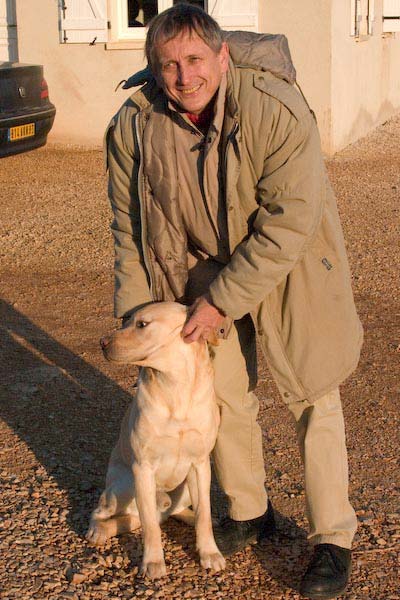
Pierre with Bou Bou, France, December 2005
Australia's truffle growers are finally getting their act together and forming their own grower's association, and I'd like to wish them well and congratulate Wayne Haslam, their first president, for getting it all together. Their inaugural special general meeting is taking place on December 9th in Canberra, and if I didn't have a prior engagement I'd be there like a shot. The NZTA has always welcomed Australian members, and I'm sure the ATGA will welcome us when we turn up at their conferences to drink their wine and eat their truffles.
TV One's Rural Delivery item about truffles featured rather less of the dog, and rather more of me than was perhaps wise, but the transcript of the item on the programme web site gives a pretty good overview of the industry today. Worth a click...
The Italian white truffle season is ramping up, and despite what's said to have been a good season, prices - in New York at least - are higher than last year. In NYC, that means $200 for a baked potato with truffle on top. Dan Dorfman in the New York Sun explains:
"The newest wrinkle in this year's truffle season — a traditional three-month annual dining experience that kicks off in October and runs to around Christmas — is the debut of a $200 baked potato at the Four Seasons restaurant that's sprinkled with white truffles. That's the highest price it has ever charged for this item and is up about 33% from the $150 it charged for the fancy spud a year ago. Why $200? Because, as one Four Seasons captain explains it, "Try buying truffles; they're running us $2,500 a pound." Last year, they ran about $2,000 a pound. An expenditure of $200 for a baked potato may seem like a prohibitive price, but not so at the Four Seasons. "We're selling a lot of them," says co-owner Julian Niccolini. The restaurant, he says, is also enjoying brisk sales on portions of pasta and risotto served with a shaving of truffles. Each of these dishes also runs $200."
Does that even resemble value for money? I suspect that the Four Seasons is a pretty upmarket restaurant, but US$200 is about NZ$300, and you can buy a lot of potatoes for that... On the other hand, the market for truffles in New York looks very interesting from a grower's perspective.
"Nicola Civetta, the amiable owner of Primavera, the city's premier power Italian restaurant, estimates diners who can afford this delicacy — essentially a fleshy edible potato-shaped fungi that grows underground and is sniffed out by pigs or specially trained dogs — will spend between $20 million and $25 million this year on a variety of truffle dishes at upscale eateries throughout the Big Apple. He figures Primavera will serve about 2,000 portions of truffles this season, equivalent to sales of between $75,000 and $100,000. Demand, he notes, continues to grow with each passing season. "I've had around 20 people a night asking me for truffles for about a week," he says."They just can't seem to wait."
I'd like to supply some of that demand... All I need is some white truffle.
Sometimes there are good times, and sometimes there are better times. The last week has been the latter. This afternoon, I received an invitation to give a keynote presentation at the Oregon Truffle Festival, in Eugene, Oregon at the end of January, and earlier in the week I heard that a proposal put together by Annabel Langbein for a presentation on truffles of the old world and the new had been accepted by the International Association of Culinary Professionals for their conference in Chicago in April.
There's a marvellous synergy about the two events. I've been fascinated by the truffles of Oregon and the US northwest since working on the US chapter of the book, and the chance to hunt them and eat them - and especially to have them prepared by some of America's finest chefs - is irresistible. And that information will carry forward into the IACP presentation - experience lending authority, and all that. I haven't been to Chicago since the late 80s, when in an earlier incarnation I had to attend the summer CES show. Blues clubs (is Kingston Mines still good?) and fantastic restaurants, and I've never forgotten discussing cricket with the Afghani taxi driver who took me from O'Hare to my hotel. I wonder if he's still playing by the lakeside...
Spring in New Zealand seems to happen in a rush. One minute it's all daffs and snowdrops...
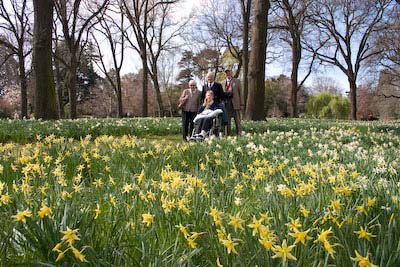
Extended family enjoying daffs in Christchurch's Botanic Gardens
...then in a week or two everything is in leaf, lawns need mowing, and you're turning on the irrigation. September in North Canterbury was certainly like that - warm and dry, but with enough winter moisture to get everything moving. Now it's raining - and very welcome too - but I know that means that shortly I'm going to have get the tractor out and start mowing the olives and truffles and orchard. Repeatedly. Perhaps I should get a new iPod in honour of the hours I'll be spending in warm leatherette seats. The old one is getting, well, old.
Meanwhile, a large digger has taken up residence down by our riverside well. It will soon (when the rain stops) excavate a deep trench to improve the water supply (this involves installing an 18m fabric sausage with a pipe and stone stiffener 4m below the surface) - then a new pump will go in to fling water up the hill and around the property. If all goes to plan, we'll have enough water for all crops, even in dry spells. This will be important to getting decent yields out of the truffieres. And it was only one truffle this year. June's visions of great truffle feasting were dashed by a plague of mice. This year, they're all going to die. And out fattest farm cat may be sent on holiday to the truffiere...
I haven't seen it yet, because it's not being broadcast until Saturday morning (Oct 7th) at 7-30am (not a time I am greatly familiar with), but TV One's Rural Delivery programme will include an item on truffles which features an interview with me and shots of Peg doing her job. You'll see a lot more of the dog than me, I'll wager, which is only fair as she is much the prettier.
Good picture of the dog, and a nice piece in the Christchurch Press today (thanks Robyn).
"I am confident North Canterbury is a good place to grow because it has a warm, dry climate in the summer and a coolish winter, similar in many respects to the climates the black truffle is grown in in Europe," Renowden says. All New Zealand growers had to do was to produce enough not only to satisfy the local market, but also to get quality fresh truffles to northern hemisphere chefs."
All? Is that all?
Aunty's been showing a bit of interest in truffles recently. Aunty BBC, that is. I don't quite know how they got hold of the idea, but the Charlie Crocker Show on BBC Radio Kent decided they wanted to talk to someone about truffles in New Zealand, and they picked on me. Charlie invited me on to her sofa (virtual, in this case) on Monday evening, Kent time - 7-15am, sunrise in NZ, and we chatted merrily for half an hour. You can listen to the show on the web, at least for a week. It's a fair while since I've been on the BBC. Back in the early 80s, when I was being a video guru, I used to claim that the only BBC station I'd never been on was Radio Three (the classical music station).
Meanwhile, over on Radio Four, their correspondent has been truffling his way round Bill & Pat de Corsie's truffiere south of Sydney, where 500 five year-old trees have produced six kilos of truffles this winter. On the way they've encountered one or two uniquely Aussie problems...
"The bloody wombats were getting in over the fence," Bill tells me. "We had no idea they could climb." Installing an electric wire has solved that problem, but it is still no deterrent to the local kangaroos, which simply hop over.
You can probably ferret around on the BBC and find the audio. From Our Own Correspondent was broadcast on Saturday 26 August, 2006 at 1130 BST on BBC Radio 4.
Email of the morning arrives from Nigel Hadden-Paton at Truffles UK, who has just had a good day out in Wiltshire:
"We sat at a table in the garden and brushed our spoils clean, then weighed them. Over 4 kilos of top quality [summer] truffle and a further 2.5 kilos of damaged or maggotted truffle — to be used for inoculum. Not a bad day at the office!"
In 40 minutes. With time to take some excellent pictures. I feel a bout of Home Thoughts From Abroad coming on.
A long time ago, on the edges of a city far, far away, I used to spend a lot of time in late summer and autumn hunting for wild mushrooms. I got quite good at it - good enough to seldom return home empy handed. This was the early 90s, and most of my competition for the fungi of West London came from expat Europeans, especially Poles with sticks. A few chefs - most notably Antonio Carluccio - were popularising what Russians call the "quiet hunt" and using the harvest in their cooking, but the supermarkets hadn't caught up with fashion.
One morning at the height of the season, not long before we left for New Zealand, I arrived at one of my favoured sites - Esher Common [map] (a remarkable place, where Brian Spooner from Kew has recorded over 3,000 species of fungi, making it the most fungally diverse spot ever studied) - to find the car park nearly full. There must have a dozen or more people unloading bags full of mushrooms into boxes. It was my first encounter with commercial picking, and they must have systematically hoovered their way through the woodland, because I could find nothing at all.
The legality of commercial picking is however open to question, as this piece by Peter Marren in The Guardian explores...
"Can we have open access and yet ban mushroom picking? In theory, we can. Any landowner can apply to the local authority for an order against blackberry pickers, moss gatherers or butterfly collectors. In this land of the free, any of Mother Nature's bounties, even the meanest, sourest berry or nut, is deemed to be private property. In the case of the New Forest, which is managed by the Forestry Commission, the Department for Environment, Food and Rural Affairs (Defra) decided that it owned the mushrooms. In the 1990s, it banned commercial picking over the entire forest, and banned foraging for mushrooms altogether in certain woods."
Marren then goes on to describe how Defra then tried to prosecute a little old lady for picking mushrooms in the New Forest, only to find the judge throwing the case out as waste of his time. Good on His Honour...
Country Life, National Radio's farming and country programme, covered the truffle business on last week's show. I took producer Tania Oolders down to Ashburton to interview John and Iris Burn, and you can hear Peg having her refresher course in the Burns' truffiere. Tania also interviewed Carolyn Dixon of Crop & Food Research, and Bill Lee, who is setting up a new truffle tree nursery (working with Tim Terry). It's a good 30-odd minute summary of the state of the business down here, and well worth a listen. Audio stream and podcast available.
Looks like it's turning out to be a good truffle season in Australia. Tim Terry has announced his first shipment of truffles to France, and Perigord Truffles Of Tasmania (PTT) are about to ship to Japan. Meanwhile, a New South Wales grower tells me that she's harvesting a kilo a week from five year old trees.
Tim's waxing lyrical about his harvest. In an item on the ABC's The World Today he says:
"It's the beginning of a coming of age, if you like. We've gone from producing a truffle, now to producing enough to put a small trial shipment into Europe, and now what we want to do is get some more feedback from them, saying we want 500 kilos a week. And that's the sort of feedback that we are getting. They want a lot of truffles and we can't supply them at the moment."
He's clearly a happy man:
"Here we are in the foot of the Great Western Tiers, there's a bit of snow on top of the mountains today, Spring, the birds are happening, truffles coming out of the ground. It's just a magnificent place and great to be alive, isn't it?"
As they say down here, good on ya, mate. Transcript here. Podcast available, but you may have to dig in the archive (originally broadcast August 3rd).
So, the proud possessor of a 26g truffle from Ashburton, found by Peg last week when she was having a mid-career refresher course, and as the good lady wife demanded it, I set about making a midwinter truffle pizza. Off to Canterbury Cheesemongers, where they were fresh out of buffalo mozzarella, but were happy to supply good flour and some fresh yeast, and then a rummage round the supermarket for some of the more ordinary mozarella (from Kapiti Cheese).
Back to the farm to get the oven going. It's been a fair few months since it was last fired up, and it was getting to late afternoon. In summer, it takes three to four hours to get up to pizza hot, which is fearsome (I had to buy a long sleeved oven glove because putting my arm in to the oven was singing the hairs). So I got the fire going, and made the dough. I used the recipe from Nikko Amandonico's book again It's very straightforward: make the dough, divide into pizza balls, and leave to rise. Then roll them flat, stretch them a bit, and cook. Easy - and good.
The oven was being notably slow in heating up. By 8pm, our stomachs were suggesting that dinner should not be further delayed, but the oven was a fair way short of full heat. When it's ready for pizzas, the interior stops being black with soot, and becomes white. A pizza cooks in a minute or so. All I could see in the light of my new headlamp LED torch was a little white patch. It would have to do.
The pizzas were simple to prepare. I shaved some thin truffle slices on to the bases, and covered them with thinly sliced mozarella. Some good olive oil brushed on top, and out into the oven. They did not cook very fast by wood-fired oven standards - perhaps four minutes before the crust was browning. This is what mine looked like...
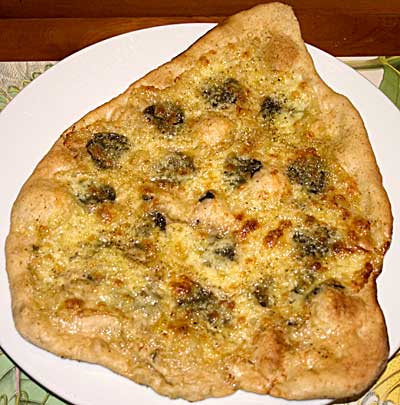
Two criticisms. The length of cooking had reduced the truffle impact - probably evaporating more aroma than a short, sharp burst of heat. The good lady wife took issue with the crust, preferring an all white flour base, rather than the mix of white and wholemeal I'd used. But they were still rather good. I also made a simple cherry tomato and mozarella pizza for second helpings.
The counsel of perfection: leave more time for oven to heat up. Use buffalo mozarella and white flour. Experiment with thinly sliced cooked potatoes as additional topping to help seal in truffle flavour. Be generous with the truffle. And do it more often.
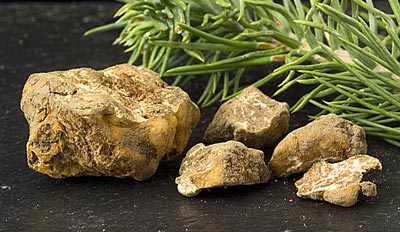
Photo courtesy of Crop & Food Research
Found on July 7th by Carolyn Dixon as she was root testing some of the young Tuber borchii infected Pinus pinea at CFR's Lincoln plantation. Congratulations to all concerned - but especially Carolyn. She's as good as any dog... (that's a compliment Carolyn, honest...). I can't wait to find out what they taste like when fully ripe, so I took Peg round my little bianchetto patch today - but she's being a recalcitrant truffle finder at the moment. She needs her nose recalibrating - and to remember what her job is. I hope to take her round a couple of productive truffieres this week, and have another dog (or two) sniffing round the Hills, to make sure she's not missed out on anything. Still waiting for #2...
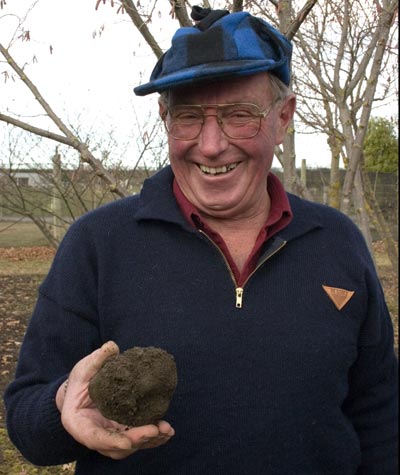
John Burn with a truffle I couldn't afford.
On the way down to Wanaka for our annual skiing holiday (mostly at Treble Cone), we stopped at Ashburton to visit truffle growers John & Iris Burn. They were holding a "harvesting workshop" (with Crop & Food Research) for South Island growers, and I wasn't going to miss that...
John & Iris were one of the original NZ truffle pioneers, planting their trees back in 1990, but they had to wait until 2004 for their first crop. As you can see from the smile on his face, John was enjoying himself - and he deserves all the pleasure just for being patient. He was offering truffles at "mates rates", and I wanted one to take down to Wanaka. Something around 30g to 50g would have been perfect. The one he dug up for me weighed 220g, and I couldn't afford it.
Press coverage of the day here, a successful sale here, and on TV One's Close Up here (the video clip was available at time of writing).
It's an awkward time. The first truffle is fading into memory, the truffle harvest in the region is getting into full swing, and I'm wondering when I'll find number two. The amazingly charming Peg is dutifully sniffing round the trees, but remains more interested in the mice than in anything else that may be under the ground. We've had visits from two truffle dogs, neither of whom showed a lot of interest - though with one of them we were doing the rounds after dark, so it was hard to be sure what was going on.
It would be rather ironic if we only had one truffle this year, and I found it by sheer luck rather than dogged skill. Ironic, but unlikely. I hope.
What did we do with the first truffle? We ate it, of course. Once you've dug up a truffle, they have about a week's shelf-life, so... I stored it in a plastic container on a bed of risotto rice and some eggs. As noted earlier, a couple of those eggs became breakfast, and very nice and truffly they were too. A couple of days later, four more eggs and about a third of the truffle went into a brouillade which my daughter and I enjoyed for lunch. A great deal.
Early the next week, after passing from had to hand at a Probus meeting where I'd given a talk, it went into my dinner thusly: I cut some flaps in the nice piece of fillet steak I had in the fridge, and inserted truffle shavings. I then trussed the steak with string and left it to truffle for a few hours. The remainder of the truffle (bar a few bits reserved for later) went into a very nice ripe bit of NZ brie. Later, I opened a bottle of good wine (Danny Schuster Omihi Reserve 2004), got some real chicken stock out of the freezer, and began making a red wine risotto with the rice the truffle had been sitting in (which, by now, was pretty smelly). When that was just about done, I added in the reserved bits of truffle, and slapped the steak onto the hot griddle. Served the steak on a bed of risotto. It was very good - but would have been even better if the truffle had been fully ripe - and if I'd left the steak longer to truffle. The risotto was perfectly delicious, but the act of cooking does drive off much of the the flavour it's absorbed, hence the need to add a few bits at the end.
The cheese was saved until Camille came back from her business trip, so that she at least got a sniff of what all the fuss was about. Still waiting for number two...
Those who have delved deep into On The Farm may have stumbled on an article on global warming that I wrote for a New Zealand small farm magazine a couple of years ago. I've been keeping up with the issue ever since, thanks to excellent resources like RealClimate and Google's news alerts. I'm certain that global warming is going to be a serious challenge for the world in the not-too-far-distant future, but I lean towards the optimistic end of opinion (ie, we can fix it, if we...). But I'm nowhere near as heroically optimistic as Marco Diacono, an Italian living in Honiton, Devon. As the BBC reports:
"Mr Diacono aims to bring in his first olive oil within the next seven years but just in case, he has planted an olive species used to frost and snow."
I think they mean an olive cultivar, and I would guess we're talking the Tuscan trinity - frantoio, leccino and pendolino - all of which are growing nicely at Limestone Hills. Even so, I would guess that there wouldn't be enough heat (yet) to ripen the fruit - not commercially, at least - for a good many years. But I did note that while staying in Kew before Christmas, olives seemed to have become a trendy front garden tree - and there was even some black fruit to be seen. Time, perhaps, for a special English revision of The Olive Book.
Meanwhile, readers who have been waiting for news of our first olive oil will have to wait another year. Blackbirds ate the lot before I got the bird scarers organised. I am therefore planning autumn feasts with songbirds on the menu. Four and twenty blackbirds baked in a pie?
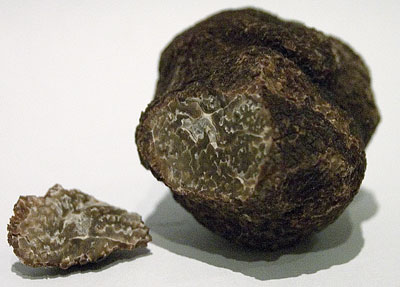
18g. Harvested at 2-25pm on Wednesday, June 14th 2006.
We were on the way out of the truffière. Peg was bored, more interested in sniffing down mouseholes than round trees, keen to get back to her bone. As she passed the last hazel, I decided to stick my trowel into the earth at its base, to see if there was much root mass close to the suckers. The little trench was a couple of inches deep, and I had a sniff of the soil - as one does - and, yes, there was a hint of truffle. Wishful thinking has led me to this point many times. Damp earth is one of the aromas in a truffle's armoury. I scraped a little more earth, carefully. No mistaking the smell. A real truffle. I dug a little more, and knocked the end off the truffle. A strangled expletive emerged. Peg was unimpressed, off after mice. I dropped the trowel and used my fingers to carefully rip the truffle from the soil. The already beautiful day - blue and cold, snow on the hills - became brighter. It wasn't fully ripe - still slightly reddish in the skin, and with brown rather than black flesh, but it had a nice scent. It looks like we're a week or 10 days away from full ripeness - in line with the expectations of other local truffle growers.
First question. What will I do with it? I'll hang on to it until next week, to use as Exibit A at a talk I'm giving. Take a few more photographs of it and its tree. Then I'll eat it. Peg and I will return to truffle hunting after the NZ Truffle Association conference at the end of the month. And she'll have to stop relying on charm to earn her bones. Nose to ground, dog...
Second question. How many will we have? No idea. It won't be the only one there, I'm sure. The hazel that produced it is not in any way remarkable, no outstanding brulée, not huge. Friends can look forward to some fine meals.
I had Oeufs aux truffes sans truffes for breakfast today. Good days begin with truffled eggs.
My views on truffle oil are probably becoming clear to readers of this blog, and I'm always glad to get support in high places - in this case from Joel Robuchon and Alain Passard in France. They're upset at the increasing use of flavour additives in classical French cuisine, of which arôme de truffe is just one example. Adam Sage covers the issue at The Times Online:
“It is shameful,” said M Passard, who claims to use only natural ingredients at his celebrated Parisian restaurant, l’Arpège. “I don’t know what to call the people who use these chemicals, but they are not cooks. Cooking is about seasons and nature.”
M Robuchon, widely considered to be one of the most talented chefs of the past 20 years, agreed. He said: “I am 200 per cent against the use of artificial flavours and additives.” However, such flavours appear to be an increasingly common ingredient in French cuisine, with chefs looking for quick, cheap recipes.
Many of the arômes come from Chef Simon, a French restaurant supplier. Their site is an eye opener. This, for instance, is how to make oeufs aux truffes sans truffes sans truffes. "Oeufs aux truffes" are truffled eggs (recipe in my book). "Oeufs aux truffes sans truffes" are truffled eggs without truffles - that is, the eggs are truffled by storage with truffles, and absorb a lot of flavour. You can cook them without truffle and still enjoy a good hit of flavour. "Oeufs aux truffes sans truffes sans truffes" are that dish made without any real truffle at all, by using their arôme. And they claim it's astonishing. I claim it's fraud.
They also suggest that it's OK to use cheap Chinese truffles, with a dose of arôme. If there are restaurateurs who think serving that to their customers is acceptable, they should be shot. But there are plenty prepared to overuse truffle oil... Education is the key. They all need to read my book...
Although Kalahari truffles are not highly valued outside Namibia, there are signs that this might be about to change. AllAfrica.com reports that scientists are looking for funds to research the truffle's partner plants - which they say is the "wild melon fruit". Other Terfezia spp have been succesfully grown in truffieres in Spain, but with a different host - the rock rose, so it will be an interesting project if it gets underway. If they can ship fresh truffles up to the Middle East, they could be on to a nice little earner, but they might be in for a shock if they think they can command the same price as Italian whites...
I don't like truffle oil. Neither does LA Times' writer S Irene Virbila:
"I quite possibly would have enjoyed the steak 'n' eggs — steak tartare topped with a quail egg — if it hadn't been so doused with truffle oil that it was like eating raw beef marinated in after-shave."
I wouldn't want to be the restaurant she was reviewing - apart from being incredibly expensive and producing uninspiring food, they were using the oil like ketchup:
"Poussin pot-au-feu is baby chicken in its juices with wild mushrooms, fingerling potatoes, fresh corn and other spring vegetables. But hold the truffle oil. In one meal, our group happened to get four dishes with truffle oil. That constitutes abuse."
I've noted before that Ms Virbila knows her truffles, and it's good to see that we agree about truffle oil too. As anyone who reads my book will discover, all commercially available truffle oils are 100% artificial, even if they have a little slice of something that looks like truffle at the bottom of the bottle. It's much easier and a lot cheaper to dose some oil with an entirely artificial cocktail of the principal chemical components of truffle smell than it is to take fresh truffle and try and make it give up its goodness to the oil.
Truffle oils are like cartoon versions of the real thing. A fresh truffle produces lots of different flavour and aroma components - the artificial versions use only the commonest chemicals to create a much simplified smell and flavour. A bit like doing a painting by numbers version of a Picasso, and then trying to pass it off as the real thing.
I use truffle oil to train the incredibly charming Peg. If I see it on a menu, I avoid that dish. I have been known to make pointed comments to waiters in posh restaurants. I mean, would they dare serve tinned asparagus?
Kalahari truffles look like "dessicated donkey dung", according to Robyn Dixon in the LA Times, but they taste good and there's a bumper crop this year, thanks to a particularly wet summer in the Kalahari.
"When Dumenikus Freeman, 40, of the Nama tribe was out hunting for truffles last month, he happened upon a haul to remember for a lifetime. In a typical season, he might walk for hours and find a few truffles. But Freeman, his wife and children, hunting in the roadside grass, were plucking out truffles every few seconds. Sitting on the ground beside his donkey cart was a sack with at least 15 pounds of truffles, and it was only midmorning. Heavy rains had robed the Kalahari in luxuriant green this year, instead of the usual red dust, and spawned prodigious amounts of truffles, a bumper season unlike any that people can remember."
Kalahari truffles are Terfezia pfeilii, a close relative of the desert truffles of North Africa and the Middle East. They lack the strong aroma and flavour of the French and Italian Tuber species, but they are still very good eating, as Dixon explains:
"Namibians are as inventive about Kalahari truffles as others are about the potato. They bake them, boil them, puree them, slice them raw with salt or serve cooked slices in a salad. Some barbecue them or grate them over pasta. Some fry them in lashings of butter and eat them on toast. Some recommend wrapping small ones in bacon and baking them whole. Others whisper their own secret: Cook them, but let them sit a night and eat them the next day, the flavors richer and enhanced. They like to slice truffles into thick disks or chunky cubes, with none of the delicate shavings, thin slices, strips, trimmings and peelings that the French truffle is usually subjected to."
Another country to add to my world truffle tour.
The incredibly charming Peg is being reminded of her chief purpose in life. This is not to wander around the garden annoying the cats, or to consume the butcher's fine bones, nor yet to sleep on my daughter's bed, but instead to apply her very fine nose to the task that will soon be at hand - finding truffles. She's getting regular reminder sessions with truffle baits (35mm film canisters with a little truffle oil on cotton wool inside and holes cut in the lid to let the smell out) buried in the truffiere, and is finding them with her customary ease. In three or four weeks the season will be beginning, and she will find me my first truffle. Or not.
The coming NZ season looks promising. There are reports of good signs of truffle from several established producers, if not yet at Limestone Hills. Meanwhile, the irrepressible Tim Terry in Tasmania tells me he has just harvested his first of the season. By accident. A trainee truffle hound did the business. Not yet fully ripe, though.
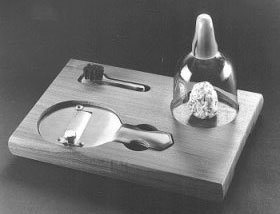
It's a "truffle set". Available at Amazon for a mere US$300. For a little glass jar, a truffle slicer and a brush. Without truffle. No comment, I might get sued.
I usually whinge about mainstream journalists getting truffles "wrong", but here's a chance to applaud someone for getting it right. S Irene Virbila in the LA Times has certainly done her research:
"Just for the record, though, when French three-star chef Paul Bocuse makes his scrambled eggs with truffle, he uses an astonishing 7 ounces of truffle for eight eggs, or just about one of the truffles we received for each egg! No butter for the maestro either, as he tells it in his 1992 cookbook, "Regional French Cooking" — just a mere dollop of crème fraîche. And once he whisks the eggs with the truffles, he leaves the bowl to sit for an hour to further infuse the eggs with the taste of truffles before he cooks them."
Her point is that it makes sense to use truffles generously, to get a real hit of the flavour, not to try and stretch them to the point that they are all but undetectable. It's a good point, well made.
Another good article on the truffle business appeared in the New York Times (registration required) recently. The author even manages to sneak in a quote from me (she was at the dinner in Barcelona I blogged before Christmas). The person most pleased, however, is Ian Hall. The NYT used one of his pictures. Fame and photographic fortune beckons. Or not.
There is a traditional French truffled chicken dish called Poularde en demi-deuil, or chicken in half-mourning, in which a chicken has slices of black truffle inserted under its skin. You then leave the chicken for a few hours to infuse with the truffle flavour, and then poach it in a stock. When it comes out, the black slices shine through the white skin. There is a picture of a chicken roasted in half mourning in The Truffle Book...
In the Spanish Pyrenees, however, a few hours infusing is not enough. This thread on eGullet (wonderful name!) describes - with graphic and sometimes beautiful pictures - the preparation of a traditional Christmas dish. Chickens are stuffed (with foie gras, milk, breadcrumbs and black truffle) then wrapped in linen and buried in the ground for up to two weeks. The precise time depends on how cold the ground is - at that time of year it's close to freezing, which it would have to be to stop the chickens rotting. When nicely done, the chickens are slow roasted, and almost certainly delicious. I'd like to conduct some confirming research, of course... [Link via Boing Boing]
...and back to the farm. Christmas and New Year festivities done and dusted: now it's time to try and remember what I was doing before I left for Europe in November. I've caught up with the accounts, paid the bills, sent out most of the copies of the book ordered while I was away, and begun to get the lawns back to some semblance of presentability. The rest of the farm is a different matter however. The truffière is not too bad: nice brulées appearing and the grass not too shaggy, but the vineyard's looking in need of a trim. The olives appear to have managed a reasonable fruit set while I was away, but it's too early to speculate about what the crop might be - and if it'll be more than the birds can eat. Now I have to confront irrigation issues (though it is raining as I write), get the mowing under control and do some weed-eating round the bianchetto and Burgundy truffieres. Time to start selling books, too.
Conspicuous consumption knows no bounds. You persuade some of your clients to donate a few quid for a charity auction, then buy a rather large truffle (see Dinosaur Dung entry), and invite journalists to come and have a sniff. £28,000 worth of Tuber magnatum. Ready to eat. Limited shelf life. So you lock it in a safe and go on holiday. The words “daft” and “bugger” spring unbidden to my mind.
It proves only one thing. Chefs know less about truffle than they care to admit, and growers outside France and Italy have a lot of educating to do. I want chefs to buy my truffles (when I've got some) because their customers will want a superb gourmet experience. The restaurateurs have to justify the cost of the truffle when they plate the meals, and the customer has to feel they’re getting value for money. If the best they can achieve is letting the things rot, then my job is going to be a lot harder.
Daft bugger.
I haven't got time to post any of the pictures from the last week, or to really do justice to events or meals - not tonight, at least - but I would like to mention vultures. In two truffle expeditions in Spain last week, in the Alto Tajo national park and in the hills not far from Pamplona, vultures were wheeling over head while we watched men and dogs find truffles. I was ready for the truffles, but the birds were something of a shock.
In the latter truffiere, in the unpronounceable but charming village of Ollogoyen, the lead truffle dog was called Lycos - "because she's a search engine". Perhaps Peg's successor will be called Google. Sponsorship possibilities...
Some food highlights: the Spanish take on black pudding - a sort of blood sausage without the skin; the mushroom lunch which finished with a "coffee" made from Trompettes de mort macerated with sweet coffee, with a cappuccino foam made from porcini cream (and the chef looked like Peter Sellers); and a truffle omelette in a modest auberge in Cahors that had more good truffle in it than most five course truffle dinners. It helps when France's leading truffle wholesaler is sitting at the same table and picking up the tab.
In France, we've seen the new truffieres of the Richelieu region just south of the Loire, the famous truffle market of Lalbenque, the Pebeyre truffle operation in Cahors, and been shepherded around local truffieres by top French truffle expert Pierre Sourzat and his dog Bou-Bou. I also have 80gm of truffle in the minibar in my hotel room, by way of a present for my kind hosts in London.
Tonight we dine chez Pebeyre, and I suspect truffle may be involved. Tomorrow we drive to Barcelona, and dinner with an American truffle importer on her yacht in the harbour. Then London and NZ. I have to say that I'm looking forward to getting back to my family and my trees. And losing some weight.
Three days in, and the relentless and exemplary hospitality is beginning to show signs of expanding my waistline. Found our first truffles on Saturday, and ate them for lunch.
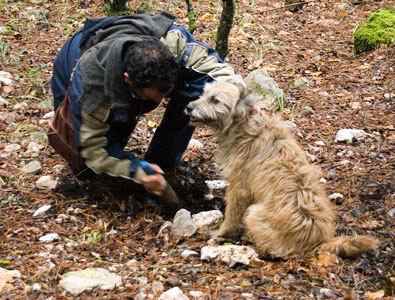
Alejandro and Jefa (the dog) get stuck in to truffle number three.
We were at the Nacimiento del Rio Mundo in the Sierra de Alcaraz, a huge and torrential waterfall issuing from massive limestone cliffs, with natural truffieres on the stony slopes below the cliffs. Jefa found three truffles, not perfectly ripe - still brownish inside rather than black, but with good aroma. The lunch which featured the truffles was both huge and delicious, an ominous sign of things to come.
The last couple of days we've been touring Don Quixote country, all ancient towns and windmills (and food). Tomorrow it's back to the truffles, this time in the Alto Tajo national park. From a slightly overfed blogger in a hotel in Cuenca, buenos noches...
Murcia,Thursday, a few hours before the conference "gala dinner": In typical Spanish fashion, tonight's meal - which will be excellent, I'm sure - starts at 9-30pm. This is late for a stomach accustomed to dinner at 7, and I haven't fully acclimatised to the Iberian lifestyle. In fact, I've sloped off early from the last session of the day in order to post this and have a nap before the festivities begin. Given that one of the world's leading truffle scientists is threatening to dance all-comers under the table, and that she ran a 100km ultra-marathon earlier this year, stamina is clearly going to be of the essence.
I'm not going to post about the science being done at this workshop, except to say that it raises as many questions about truffles and their cultivation as it answers, but I have learned a hell of a lot: about the truffles of Hungary, the new truffieres of Chile, the truffles of Spain and the mushrooms of the Spanish regions, and the formation of a truffle association in British Columbia where keen growers have already planted their first trees. I have also met a scientist from Finland who is convinced that he's got a good shot at growing the Périgord black up in that frigid corner of the world. Plenty of material to fed into the NZTA research programme, and into the next edition of The Truffle Book - if it ever gets that far.
But it's the networking that's most useful. Putting names to faces, seeing people again, reinforcing links and forging more. I've even sold virtually all the copies of The Truffle Book that I shipped over from NZ. (Thanks Pilar and Asun). So far, nobody's grabbed me by the arm and pointed out any terrible mistakes, for which I am deeply grateful.
Tomorrow afternoon the great truffle tour really begins. If I can get some decent internet connections, I'll try and blog the highlights...
Renowden's first law of truffle journalism states that, however good the story, a journalist writing about truffles will inevitably end up spouting bollocks. Today it's the turn of the Daily Telegraph's Hilary Clarke [Link].
I mean, it's a good story. Soaring truffle prices driving tartufaio to piracy in an attempt to cash in on soaring prices. "...the village bars in the hills around Asti are awash with tales of sabotage and skulduggery. Car tyres have been slashed, paths scattered with nail barbs and poisoned meatballs left in the undergrowth to kill hunter's dogs." Happens every year, but let's not let that get in the way of the story.
Where Clarke goes hilariously off the rails is in her attempt to find a telling description of what white truffles are: "White truffles are fungus balls that smell of rotten eggs but taste of garlic." Pardon? These things that sell for £1,100 a kilo smell of rotten eggs? And taste of garlic? The byline states that Clarke is actually in Asti (not very far from Alba, in the Piedmont), but if that's the case, surely she could have managed a slightly more educated sniff. Or perhaps she's anosmic.
One suspects that the celebrities attending this year's big charity white truffle auction in Italy will not be paying through their collective noses for something smells of rotten eggs. And I hope that if Roman Abramovich (Chelsea FC owner) and Gwyneth Paltrow buy a truffle this year, they will ensure that their chef doesn't let it rot before they get a chance to taste it.
It's taken me a while to do it, but I've finally managed to edit the TV One news item about this year's NZ truffle dog trials, shrink it for the web, and figure out how to post it to the Limestone Hills website. Click on over there, and see Peg win! I get precisely two short sound bites, but Ian Hall and Christina Weden are much more cogent in any case. (3.1MB, Quicktime required).
Gordon Ramsay is a chef with a fearsome reputation - and tongue, if you have seen him on TV lashing some hapless young proto-cook on his cooking "reality" shows. He is, of course, an extremely fine cook, possessor of Michelin stars and the culinary gravitas that goes with that, and is therefore unafraid to charge like a wounded bull when the situation demands it. Which, at his Ramsay's Maze in central London, it apparently does, because a pizza with white truffle shaved on top costs £100. The Daily Mail (I used to write a column for them in the early 80s) explains all...
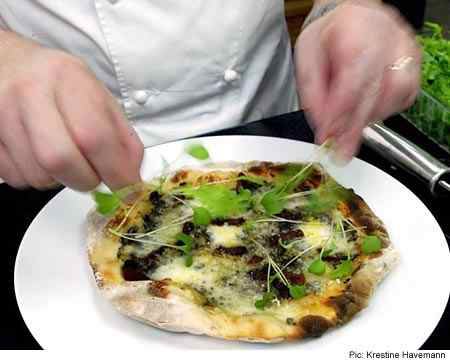
Looks very nice, as you'd expect. But I'd rather make my own. And I wouldn't shave truffle on top either. I'd make a pizza bianca, as I blogged earlier this year. But then I'm not Gordon Ramsay.
The northern hemisphere truffle season is getting under way, and while there are signs that it could be a good year for Italian whites, French trufficulteurs are worried that summer drought and excessive heat will lead to a poor harvest of Périgord blacks.
A report in The Daily Telegraph (registration required) forecasts that prices for melanosporum will break through 1,000 Euro/kg for the first time. The piece quotes Gilbert Espenon, vice-president of the French truffle growers Federation (FFT): "It did not rain from late April until now and the Mistral wind was very strong, which dried out the soil even more." Meanwhile, over the Pyrenees in Spain, it's been a long hot summer, with Portugal experiencing a record drought. If there hasn't been significant late summer rain in Spain's truffle growing regions (a rough sort of triangle between Madrid, Barcelona and Valencia), then production there will also be hit.
Over the Alps in Italy, it seems there's been good rain, and Italian restaurants in New York are expecting a bumper season. Lower prices will allow them to reduce the cost of their white truffle masterpieces. Dan Dorfman in The New York Sun interviewed Nicola Civetta of the "classy" Primavera: "Mr. Civetta, whose truffle policy is "to buy the best of the best," says he's initially paying $1,300 a pound this year, versus $1,700 to $2,000 a pound last year. Accordingly, his full-portion pasta and risotto truffle dishes, which averaged $95 to $98 in 2004, are being scaled down this year to $79."
The average price mentioned in the article is about US$1,000 per pound, or US$2,200 per kilo, equivalent to NZ$3,200/kg. That's a good price for top quality Italian white. Those "full portion" pasta and risotto dishes don't look cheap though. They might be cheaper than last year, but that doesn't mean affordable - not to New Zealander who thinks that NZD $35 for a main course is distinctly upmarket.
Mr Dorfman also proves my rule about all journalists eventually spouting bollocks about truffles. Quite apart from buying into the marketing myth that it's Alba that produces the finest truffles (Alba's market quite happily sells truffles from all over Italy), he then produces this absolute classic: "Likewise, truffles from Alba will look like a golf ball, whereas those from Tuscany and Umbria will look more like a squashed potato." I think he may be beating around the bush with the wrong end of a large stick.
Can humans learn to hunt truffles by nose alone? According to some new research by a team at Berkeley, they can.
From the press release: "In a review appearing in the same issue of the journal, Jay A. Gottfried of the Department of Neurology at Northwestern University's Feinberg School of Medicine noted that the UC Berkeley findings open numerous avenues for further research. "Finally, what are the implications for the Provençal truffle hunt?" he wrote, only partly tongue-in-cheek. "In the traditional world of the truffle forests, the dog (or pig) is king. The evidence presented here suggests that humans are every bit as well equipped to carry out the search."
"Every bit as well equipped" as dogs? I think not. My experience suggests that if you are in a truffière that has a lot of ripe truffle in the ground, and the air is very still, you might smell truffle. You may also be able to say that the smell is stronger in one area than another. If you were to go on hands and knees and place your nose close to the earth, and then crawl around sniffing, you might be able to home in on a ripe truffle and dig it up. Time taken to find truffle? Being very generous, perhaps five minutes. Number of times each season the necessary conditions occur? Seldom.
Let us count the ways that dogs are better than humans at finding truffles. They have four paw drive, and are close to the ground. The nose/soil interface is achieved without ungainly crawling, and in running mode they can cover a lot of ground in a short time. Their olfactory apparatus is many times more sensitive than ours, and their brain is much better equipped to process the incoming information. A good truffle dog prefers a slight breeze to waft the truffle smell around and give them something to track. A dog will home in on the precise spot where the truffle is hiding and mark the spot with a scrape of the paw, and then politely wait for a small reward.
I'm sticking with the amazingly charming Peg.
This picture arrived recently from Australia: I am both jealous and salivating...
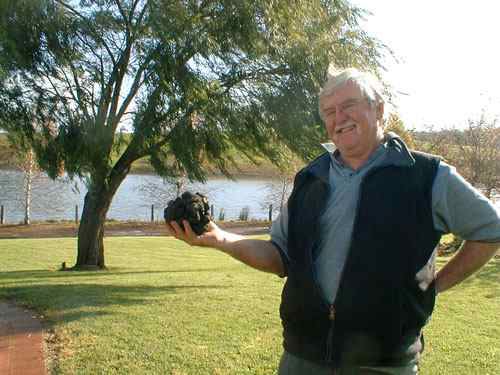
Nick Malajczuk looks (unsurprisingly) rather pleased with his 1kg+ monster truffle.
I've been doing some checking up on NZ's largest truffle. Alan Hall believes the biggest he has ever found was about 760g (and there's a picture of what might be it on his web site), but his brother Ian believes that a bigger one turned up at about the same time ('97 or '98). Still, it looks as though Nick's claim to the largest black truffle found outside Europe is justified. Congratulations! Thanks for the picture Nick, it's going in the book...
It's turning out to be a bumper season in Australia. Hot on the heels of New South Wales' first truffle, and Tim Terry's reports of a good harvest under way in Tasmania, comes news of a 1kg truffle found at Nick Malajczuk's Western Australia truffière. The linked article in The Australian claims that it is the "biggest harvested outside France", and at 1,018.5gm that may be true. Or it may not. In the mid-90's, when New Zealand's pioneer grower Alan Hall was hauling big truffles out of the ground, he also found one that weighed over a kilo. Was it more than 18.5gm over the kilo? I can't remember, but I'll ask Alan next time I see him. In 1997, I saw several that weighed over 500gm being harvested, and that was impressive enough.
Victoria is also getting in on the act, with young trees at Greg Kerr's Yellingbo property, 60km east of Melbourne producing their first truffles. The Age has the story [registration required], as does the Herald Sun.
Meanwhile, The NZ season is progressing nicely. Peg's been round to a neighbour's place and found a truffle or two, but she's not showing any interest round my own trees. I haven't given up, though. She'll be sniffing for her supper for a month or so - and there's the borchi trees to keep a nose on too.
We harvested all our olives on June 18th. Lovely warm day. Total of 18kg of fruit, well up on the handful of the year before, but well down on the 50kg I was expecting. The birds - despite some noisy bird-scaring gear - had obviously been busy. I took the fruit to Athena Olives in Waipara, to be thrown into the pot. No Limestone Hills oil this year, but unless we have some sort of climatic disaster in the coming year, I'm confident we'll have some next winter. Next on the olive grove task list: pruning and fertilising. I'll do some light pruning at the end of July, and give each tree a feed in August.
One last blog from that busy Queen's Birthday weekend: a picture of a truffle in the ground at the North Canterbury truffiere visited by the NZTA tour.
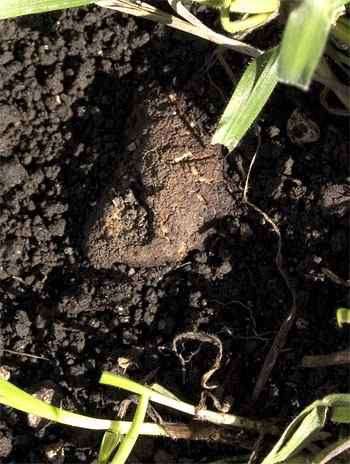
It wasn't fully ripe at the time, but has recently been harvested. If only they were so obvious at my place... (Still no sign of truffles at the Hills. Peg had a good sniff round yesterday, but didn't show any interest. Fingers still firmly crossed.)
It was only one, but it made Professor Wang Yun a happy man. After Peg had done her stuff in Hagley Park, the NZTA conference attendees jumped on a bus for a visit to a productive truffiere in North Canterbury, and then on to Limestone Hills. Wang was on the tour, but instead of joining everyone in the truffiere, he headed off to the little patch of Pinus radiata infected with Lactarius deliciosus that I planted as part of a trial three or four years ago. Mine was the only plantation that had not produced, so Wang was interested to have a look and see how things were going. And this is what he found…
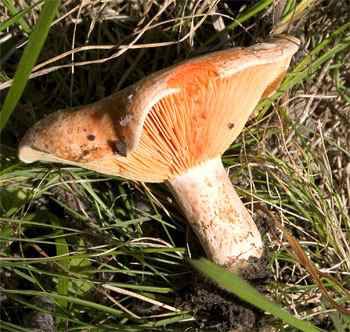
A perfect little saffron milk cap, all on its own in North Canterbury.
Why mine was so slow to produce is something of a mystery. It is probably down to the fact that I used glyphosate to keep the young radiata plants free of weeds. This fruiting body was down in a little rabbit scrape, barely sticking its cap above ground level. Next year, the mycelium should have fully recovered, and as the trees have been growing vigourously (they have irrigation) I hope to get a much more substantial harvest..
Wang's the man behind the introduction of saffron milk cap to New Zealand. The mushroom is commonly sold in European markets, and as the Latin name suggests, is highly regarded as a culinary mushroom. In Australia, where the fungus was accidentally introduced in pine plantations (especially in Victoria and New South Wales), there is a thriving local market supplying restaurants. Market price is usually around $50/kg. Wang's idea is that if foresters planted trees infected with mushrooms, they would benefit from an income stream while waiting for the timber to mature. In fact, it's possible that the mushrooms could be worth more than the wood.
At Limestone Hills, our aim is much more modest. I just want to grow enough to be able to have some good feeds every year. I cooked the one in the picture, sliced, in a little butter. It lived up to its name.
The second annual NZ Truffle Association truffle dog championships were held in Hagley Park, Christchurch, on the Sunday morning of Queen's Birthday weekend. And Peg won again. It was not a fix. She did it in front of TV cameras from TV One, and if I could work out how to grab the section from the DVD recording and drop it down in size, I'd host the segment from the evening news here. But I haven't got time to fiddle with that, so I won't. She is, however, still a star - even if she hasn't yet found a truffle at the Hills.
The Queen (Elizabeth 2nd of Great Britain) is a lucky woman: she has several birthdays. In NZ, her official birthday is celebrated with a holiday on a Monday in early June. Australia also celebrates Queen's Birthday, but a week after NZ, which is when Britain does it (I think). And then she has a real birthday too, when Charles and Camilla probably turn up with a box of chocolates and some cool new music for Liz's iPod. Queen's Birthday weekend is when the NZ Truffle Association holds its Annual General Meeting and conference. This year was Christchurch's turn, and getting it organised was one of the things that kept me off the net for most of May. Last year we invited two international speakers: neither made it. This year we tried again, and both made it. Christina Wedén flew in from Sweden to tell us how she had (almost) single-handedly created a truffle business on the Baltic island of Gotland, and Tim Terry, grower of Australia's first Périgord black truffle, came over to tell us how good his season was going to be.
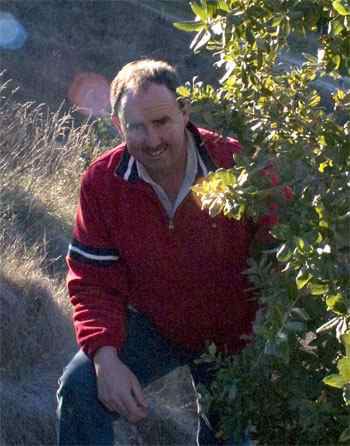

Christina and Tim (sorry Christina - but this photo is much better than the other one...)
We hosted them up at Limestone Hills for a couple of nights before the conference. Christina was keen to see our little aestivum/uncinatum truffiere (which includes trees infected with inoculum she provided), and Tim was only too happy to satisfy my curiosity about events on the other side of the Tasman (of which more later). Good company, and more invites I'd be a mug to ignore...
It's been a long time between entries: I blame the season, the need to work on the book, the truffle association conference, etc and so on. It's over a month now since Patricia Wells, the Provence-based American food writer, cookery guru and International Herald Tribune restaurant reviewer visited Limestone Hills. She'd just won a James Beard Award for her Provence Cookbook, and was understandably chuffed.
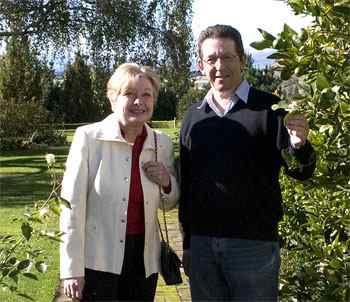
The sun shone...
She was over here to take some masterclasses at the Savour New Zealand weekend in early May. She expressed an interest (in a radio interview) in finding out about NZ's truffle business so I was happy to oblige. Patricia was charming and very interested in what we're up to. I now have an invite to visit her in Provence during the truffle season - one of those offers you can't refuse. And if you're interested, her truffle cooking class in January 2006 is US$4,000 for the week (and sold out long ago).
The first truffles of the winter season are turning up in New Zealand and Australia, including first production on very young (third year) trees in New South Wales. Tim Terry, one of Tasmania's pioneer growers and the man who found Australia's first black truffle in 1999, tells me that the truffle was found under a young Quercus ilex (holly oak). More information here, here and on Tim's website. Tim's coming over to give a talk to the NZ Truffle Association conference next weekend (Queen's Birthday weekend) and will be spending a few nights in Limestone Hills, so I'll be digging for more info.
Meanwhile, the New Zealand truffle harvest is already underway, with ripe truffles reported from several North Island truffieres. Down here in Canterbury, two truffieres have already made their first finds, but of unripe truffles. May in NZ is equivalent to November "up North", and in Canterbury we reckon optimum ripeness isn't achieved before the end of June - which fits in nicely with French tradition. French gourmands will tell you that the best truffles are found after Christmas - which in our case translates to after the shortest day.
So will I find my first truffles at Limestone Hills this year? Still too early to say. I haven't noticed any sticking out of the ground (which is how the two local finds of unripe truffle were made), and my brulées are not as obvious as last year. A couple of wet months has prompted a fair bit of weed growth, but that doesn't mean the fungus isn't alive and well and fruiting happily. My fingers, and several other appendages, are crossed.
Today was beautiful: the perfect autumn day. Incredible deep blue sky, the poplars turning yellow, and dew on the lawns. The truffiere's looking good, there are olives in the grove, and tonight's dinner featured an all-garden ratatouille (yellow courgette, baby aubergine, chilli (two kinds), red tomatoes and green tomatoes, oregano and basil. Served with stuffed marrow - a courgette that got away. We did pizzas in the wood-fired oven on Sunday, and they were rather tasty too. Holidays now. While MIke the editor labours over my turgid prose and a designer friend (Tony Cohen in London) considers typography, I shall whisk my family off to Rarotonga and Aitutaki for 10 days. It'll rain.
Summer is tailing off into autumn, the nights are drawing in, and thoughts are turning to the winter truffle season. Last weekend, the amazingly charming Peg had her first refresher course of the year - just a quick sniff to see if she remembered what she was supposed to be doing.
I have four 35mm film canisters with pierced lids in the freezer. Each contains a chunk of last year's truffle. All I did was bury them a couple of inches down in the soil around four trees, and leave them there for an hour or two to develop some scent. Then I ran through Peg's pre-hunt routine: on with the collar and lead, a couple of strips of Schmakos as treats stuffed into a pocket (she spots that unerringly), grab a trowel fromthe garage, and then we walk down to the truffière. We get to the trees, I tell her to start sniffing, and off she goes. She finds all four in about three minutes - too easy. Next time I'll have to make her work harder, perhaps by scattering the baits over a larger area. But it was good to see that she remembered what her job is. All I need now is some reassurance that the real things are forming in the brulées round the trees. My appendages are crossed.
Chinese truffles look a lot like Perigord Black truffles, cost a lot less, but have less flavour and aroma. They've been a major source of fraud over the last ten years. Time Asia digs into the issue this week, and provides plenty of colourful info:
From the French perspective, the bad news in this piece is the discovery that Tuber indicum out-competes melanosporum. There are fears that indicum may find its way into French truffieres, even unconfirmed reports that it's already happened.
"We saw in experiments that Tuber indicum is very dominant, competitive and aggressive," frets Gerard Chevalier, a researcher at INRA. He paints a scenario in which errant spores from imported Chinese truffles disperse into the air, contaminate the French countryside and do ecological battle with their more fragile cousin."
It might be better for the rest of the world if the Chinese discovered a taste for their own truffles, but that doesn't seem likely:
"None of that, though, changes one irksome fact that has limited Wu's business. For all their gastronomic enthusiasm for endangered sea animals or all matter of rare mammalian life, the Chinese so far appear immune to the pleasures of a black truffle. Mushroom gatherer Li Kun shakes his head when asked whether he enjoys the flavor of the black nuggets he's scooping up from the loamy soil near Hama. "When we're really hungry, we eat them covered with soy sauce, coriander, chili paste and MSG," he says. "That way you don't have to taste the truffle too much, only the sauce."
Oregon has more than white truffles. The Portland Times has a very interesting piece on Oregon Black truffles, praising them highly:
"It’s like a treasure hunt,” says Jim Wells, a director at MycoLogical Natural Products in Eugene. Mycology is the study of fungi, and this company specializes in wild mushrooms, including truffles, picked from the surrounding forests.Wells is a proponent of Oregon black truffles, which he calls “the premier truffle on the planet.” They’re fruity and versatile, he says, with a subtle flavor that changes from day to day.
Like many fans, Wells thinks that Oregon truffles are under-appreciated. He says people often don’t realize how good the local product is because they taste truffles that have been mishandled. Both black and white varieties are extremely fragile, and a few days can make the difference between superb and dud. European truffles have the advantage of a longer shelf life."
I suspect that describing the Oregon black as the "premier truffle on the planet" is either good salesmanship or betrays a sad lack of knowledge of other black truffles, but the Oregon white is certainly worth attention. Charles Lefevre, in a recent email (where he thanks me for the "tongue in cheek" comment below), tells me of a trial he recently conducted between tuber magnatum and good specimens of tuber gibbosum:
The season for the Oregon truffles has been outstanding this year. The truffles have been large, plentiful and very aromatic. I think the power of the Oregon truffles is among the many well-kept secrets in the truffle world. I did an informal taste test comparing the Oregon white truffle with the Italian white truffle at a holiday party in December. I had a local chef prepare gnocchi in a cream sauce and shaved Oregon white over one half and Italian white over the other. [...] And the results...every single person there who I got around to interviewing felt that the Oregon white was both stronger and better. What condition, you correctly ask, were the different truffles in? The Oregon whites where at their best, selected from among several hundred at the local truffle purveyor's shop. The Italian whites were at least a week old and fading. It wasn't a fair comparison. However, I paid $1800.00 per pound for the Italian whites (the lowest price I could find) compared with about $100.00 per pound for the Oregon whites. The result of this experiment in my mind is not that the Oregon whites are better truffles than the Italian whites, but they are perhaps substantially better than their price and reputation would suggest.
Given that Italian whites are my favourite truffles, and I've never tasted the Oregon kind, whether black or white, I think that's a very fair conclusion. On the other hand, I may need to stump up for an airfare to Oregon in the truffle season.
PS: There's more about both Oregon truffles (and Charles) in a recent issue of the Audubon Society's magazine. [Link]
Truffle poaching is becoming a real problem in France, according to Newsweek. As much as 10 percent of this season's crop may have been stolen, truffle growers are up in arms, and the gendarmes are out in force with night vision goggles. But is there a high-tec answer?
In December, Cholin proposed embedding a microchip in truffles to track stolen ones using Global Positioning System satellites. The idea was discussed at a meeting of the French Federation of Truffle Growers, but didn't go far. One drawback: police would have no way of distinguishing fleeing thieves from roaming boars, who also fancy truffles. Another: the tracking technology is similar to the radio transmitters naturalists use to follow birds, but it won't be small enough to go unnoticed in truffles for another decade, according to Franck Pantaleo, head radio-communications researcher at Saphelec, a firm in Marseilles.The technology is, however, compact enough to hide in cigarette-size beacons at the bottom of truffle crates, for a cost of less than 500 euros. "The truffle market is taking off right now," says Marc Le Floch, head of sales at Cadden, a Nantes-based seller of the beacons. Ludovic Blanc is one broker who probably wishes he had a tracker: after he left a truffle market in Aups two weeks ago, bandits brandishing firearms sideswiped Blanc's car and forced him to stop, then relieved him of some 40 kilos of truffles.
Jean-Marie Rocchia, a producer from Beaureceuil, thinks he has a better idea. Rocchia drills holes in selected tubers still in the ground and inserts tiny rolled notes in each. Truffles harvested by hands other than his hold a warning for chefs: their black diamond is stolen, and the seller should be reported to the police.
There are times when living a French idyll is not all that appealing. But I do like M Rocchia's witty solution. He's the author of Des Truffes en général et de la Rabasse en particulier, a wonderful tome that takes a knowledgeable and irreverent look at the world of truffles. Recommended if you can read French.
If our British friend has some optimistic views on truffle yields, so does Charles Lefevre of New World Truffieres, in Eugene, Oregon. According to Forbes, he's dreaming of a white (Italian white) Christmas:
His other goal is to cultivate Italian white truffles--a feat he says no one in the world has yet accomplished. He has inoculated seedlings with Italian white truffle and kept the resulting mycorrhizae alive for three years, so far. "If you could cultivate Italian whites," he says, "and if your trees managed to produce a hundred pounds per acre--which is common with French blacks--then at $2,000 a pound you'd make $200,000 per acre per year."Lefevre dreams on: "If you had 10 acres, you could work leisurely for maybe five weeks each winter and have a $2 million annual income."
When truffle pigs fly.
Having met Charles, I think I can say that his tongue must have been firmly in his cheek. The Forbes article is worth a read, though.
The truffle business in Britain is hotting up. First there was Truffles UK, set up by Nigel Haddon-Paton and Adrian Cole to produce truffle-infected trees using technology licensed from New Zealand. Now there's a young bloke called Paul Thomas who has been trying to raise money to set up truffieres using trees infected using technology he's developed. He even took his quest to the BBC, who featured his business on Dragon's Den a week or two ago.
The latest news is, apparently, that his deal has fallen through. His website suggests that:
Using 2,500 of our trees on a 5 hectare site, we should achieve a production in excess of 1000 kg per year. That represents an annual turnover in excess of £1Million.
In other words, 200kg of truffle per hectare. On every hectare. Optimistic would be a mild word to use to describe that yield. Perhaps that's why the deal didn't work out. In my experience of seeking funding for start-ups, you don't dazzle your backers with promises of huge returns: nobody will believe you.
What do I think a reasonable yield might be? 20 to 40kg/hectare. That's achievable, in our experience in NZ, and still gives you a good return. Good enough for me, anyway.
I've been working on my chapter about dogs. In browsing the web for pictures of truffle dogs, and especially the Italian breed called lagotto romagnolo, I came across this site. Grist to the mill: they look like a sort of poodle crossed with terrier. Not as charming as the incredibly charming Peg, but they won't chase rabbits. An advantage when rabbits are everywhere.
Peg's two next month, and I know that some time in the next few years we'll have to start training her successor. Would a lagotto be good? I had dismissed the idea as being too convoluted and expensive when I clicked on this:
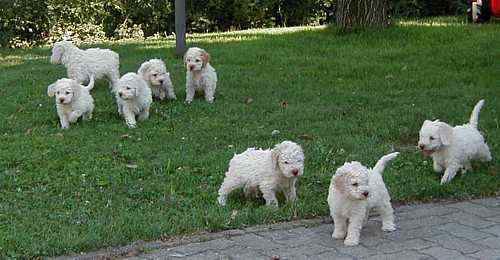
I daren't let my daughter see this, or expensive dogs will be flying round the world.
Someone threw a switch on or soon after January 12th. The weather stopped being cool and wet and started being warm and dry. And as usual, things started going wrong with our irrigation set-up. Nothing new there: I have a long relationship with failing pumps, wells that silt up, pipes that block, and springs that dry up. Over the years, an observer might have reported me apparently playing a giant black plastic Alpenhorn in an attempt to unblock it, scrabbling face down in a muddy spring trying to improve its flow, or trying to clear airlocks in a black plastic pipe that has boiled the water inside it.
I love water. I revel in it. I like to drink it, cool and refreshing. So do my plants and fungi. And getting enough of it to keep them happy is a permanent struggle.
When we moved in to Limestone Hills, the only water we had was the 1,000 litre/day rural drinking water supply, and shared access to two springs on the hill behind our property. When we remodelled the garden, we installed a 25,000 litre tank just below the olive paddock, filled from one of the springs, and pumped it around 14 zones in the garden. I was left with two zones for the olives and truffle trials, while the other spring handled the main truffiere. With the climate throwing an El Nino drought at us, and then a La Nina drought, and even an inbetween drought, our supplies were tested, and found wanting. But only after I'd spent hours, days, weeks fiddling around with springs, pipes and sprays.
So we applied for permission to put a well in down by our river, and the right to take a modest amount of water out of it. The well was built, power lines laid down the hill, and a pump installed. Water flowed up the hill, into the original tank, and we relaxed. Then, in August 2000, we had 150mm of rain in a day, and the Waipara River (annual average flow, 4 cumecs - cubic metres per second) shot up to 350 cumecs, flooding the well with silt and nearly destroying the pump. We've been making do with that ever since. It's not enough.
We need water for the garden (more important than my crops, according to my better half), 250 olive trees, two trial truffle plots, a dozen walnuts, a few pistachios, 1500 vines, and 220 black truffle trees. And I want enough water - enough that I don't have to try and work out which crop needs the water most, trading one off against another. So we're looking at the feasibility of building a large pond down by the river (one that's flood proof, of course), which we can fill from the river over winter when there's plenty of water flowing down my boundary. And some larger pumps, so that we can chuck lots of water up the hill and round the farm.
And then I won't envy my organic neighbour, with his giant rain gun shooing great plumes of water 30 meters up in the air, clicking mechanically through the night, looking cool in the heat of the day. Or we might dig a swimming pool...
Imagine a Noddy Holder sort of noise... Christmas down here. Drizzle. Cool. Turkey in the oven, family on the way over. Much preparation to be done. iPod shuffling through all sorts of Xmas music, from Stax/Chess Christmas to Musica Antiqua. Not much blogging to be done today. Just eating and drinking. I hope.
Compliments of the season to anyone who pops by. Drinks on me.
Pip pip!
It is a truth universally acknowledged (my daughter’s watching Pride & Prejudice on her iBook as I write) that when a mainstream journalist tackles truffles, he (or she) will spout bollocks. Today’s ration comes from The Times. (Incidentally, I checked the use of italics for The Times, and discovered that they have their style guide online. Marvellous!)
The author, one Alan Hamilton, had clearly had a good lunch when he wrote:
“There are male and female truffles; inevitably, the female is favoured, having the stronger aroma.”Since he fancies he knows what dinosaur dung smells like, he may be forgiven this error. Truffles may have sex, but we know precious little about it. And I have never, ever, heard anyone talk about truffle sexing as a key part of truffle quality control.
But I wish I'd had his lunch...
It’s the holy grail of truffle production. Tuber magnatum, the Italian white truffle, the most expensive truffle on the planet, has wilfully resisted all efforts to cultivate it in plantations. Now an article by Elizabeth Luard in that British magazine institution, The Spectator, suggests that success is close at hand. You’ll need to register to read the article in the “Irregulars” section of this week’s issue (06/11/04), but it’s worth the effort, if only to read something in the relatively mainstream press that goes beyond the obvious caviar and champagne metaphors and isn’t afraid to use a few scientific terms. Thanks to Tony Vickery of the erstwhile enchiridion blog for drawing my attention to it.
I visited SantAngelo in Vada in November 2000, as part of my European research trip for the still unfinished book. It’s a charming place, and the scientists at the truffle research centre are just as charming, if in a slightly oddball way. Perhaps that’s why Mrs Luard fell for the pheromone stuff:
Pheromones, for the uninitiated, are the stuff produced by football fans when they do the Mexican wave, by cabbage whites to warn other butterflies where they've laid their eggs, and by people and pigs to attract a mate. They are also, as it happens, produced by truffles as a means of spreading their spores. Not to put too fine a point on it, when ripe and ready, the truffle reeks of sex. You don't get the full impact unless you're there. A sow will automatically search for truffles thinking, from the smell, that there is a boar around.
It’s a seductive theory, and a tale I’ve retold myself, but it isn’t true. A French scientist demonstrated quite convincingly that pheromones have nothing to do with it. The most active part of the smell of truffles as far as mammals are concerned is a chemical called dimethyl sulfide, or DMS. It’s the smell of cooking cabbage. There is a substance very similar to androstenol - the pheromone in question - in the aroma of black truffle, and when researchers discovered that they leapt to an obvious, if erroneous, conclusion. Good stories take a long time to die.
Mrs Luard gets some other stuff wrong as well:
While the Perigord black, Tuber melanosporum, prefers oak and lime, poplar and hazel appeal to T. magnatum Pico, the Piedmont white. (Lesser species are more likely to go for beech and fir.)
Actually, melanosporum likes oaks of various kinds, hazels and some pines, while magnatum likes limes and poplars.
So are the good Dottores of SantAngelo in Vada succeeding in their quest? I may have to email my contact, the very charming Dottore Gianluigi “Gigi” Gregori to find out. There’s only one slight problem. He speaks no English, and I no Italian. We spent three days in 2000 conversing in broken French. I’ll keep you informed.
Peg (the amazingly charming truffle hound) had her last truffle-hunting gig of the year this morning - sniffing around a plantation of young trees infected with Tuber borchi, known in Italy as the bianchetto or marzuolo truffle.
She was good, too. I took two film canisters with some frozen black truffle inside for Carolyn to hide while I was putting my boots on, and despite the decoy holes Carolyn had dug, Peg stuck her nose in the air and hunted out the baits very quickly. If nothing else, it proves that she still knows what her job is. Hunting out truffle baits like this keeps her nose in, and gives me a chance to reward her - positive reinforcement even if there are no real truffles to find. And there weren’t.
Tuber borchi is a white truffle, similar in some respects to the famous Italian white truffle, Tuber magnatum. It doesn’t have the superb reputation (or high price) of magnatum, but Italian experts reckon that good borchi is close. Given that magnatum has never been successfully cultivated (though many have tried, and continue to try), borchi offers truffle growers a shot at growing something to fill that market niche. Borchi has been successfully produced in at least one truffère in Italy, and in NZ we’ve got several plantations, the oldest of which were planted four years ago. I have 35 trees at Limestone Hills, and half of them are from that first batch. No sign of truffles there, sadly, but I live in hope.
Borchi is interesting in a New Zealand context for a couple of reasons beyond the purely culinary. It is a winter to spring truffle. The season in Italy runs from January through to the end of April, which translates roughly to July to October down here, and so it offers a chance for growers to extend their season. Tuber uncinatum, the Burgundy truffle (aka the summer truffle that can be found in Britain) extends the season in the other direction, so that’s being experimented with as well - and I have some of those too. With three species in cultivation, we have the prospect of a truffle season that might extend from March to October.
The other interesting thing about borchi and uncinatum is that they are known to fruit over much of Western Europe - from Britain to Italy - and so they are more climatically tolerant than the finicky Perigord black truffle. Regions of New Zealand that are currently thought to be too cool or too wet for black truffle might be fine for the other two.
Neither truffle sells on world markets for anything like the prices commanded by melanosporum or magnatum, and until we have produced some in New Zealand and established a market, it’s very hard to estimate what they might be worth to growers. Even modest assumptions, however, suggest that they could be more lucrative than most other tree crops.
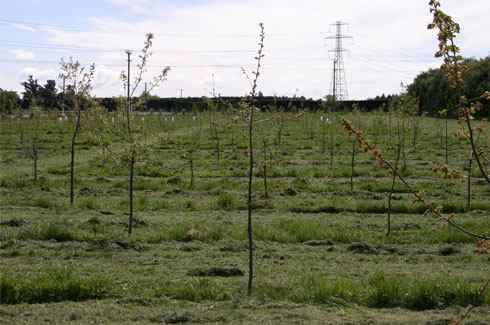
Crop & Food Research’s three year old 700 tree T borchi truffiere at Lincoln, near Christchurch
This is where Peg did her thing. The grass is being mown prior to a late spring soil tillage (it has to be done after fruiting has finished), and no chemicals are being used. Italian researchers have suggested that Roundup/glyphosate might affect the truffle mycorrhiza, so Crop & Food Research are doing all weeding manually - something I shall do on my block as well. The trees are a mixture of oaks, hazels and several pine species (radiata, pinea, picea). In the Italian trial, Pinus radiata infected with borchi produced after four years, so with good luck and following wind, one of our NZ truffières could begin production next year. I hope it’s mine…
I collected the repaired mower last night. A shiny new engine which sounds smooth and lusty and perky. I’m not a “petrolhead” (as motor enthusiasts are called down here), but I did notice a distinct difference to the old machine that can be summed up as “more oomph”, and it’s quieter. So I started mowing the 10 days growth off the top of the lawn. Did that, then started doing the orchard. Rain decided to fall in sufficient quantities to make the grass greasy, and the slopes unmowable, so I stuck the amazingly charming Peg in the car and tootled off to the office.
A marginally productive day, but the quince flowers looked rather lovely.
Monday dawns sunny and warm. By the time I've got the tractor full of diesel and hooked up to the cultivator (and the iPod firmly attached to my belt), I'm beginning to feel distinctly hot. There's a bit of a nor'wester blowing, the sky is very blue, and the tractor is behaving itself, so I tie the amazingly charming truffle hound to her chain (to prevent her disappearing, tail up, in pursuit of me, but mostly rabbits - for hours) and chug off to the truffière. The tillage proceeds well. The tines (see first entry in this category) are supposed to loosen up the top 10 to 20 cm of soil, generally aerating things before the truffle mycelium begins its spring growth. This is supposed to encourage the formation of truffles. I live in hope.
At lunchtime, the hound is ridiculously pleased to see me. She's been wailing piteously, I'm informed. News to me, of course, because a rusty old Kubota that saw its best days on a Japanese rice paddy is not the quietest tractor on the planet, and it was being masked by the iPod on random play. Apple assure us that track sequencing really is random, but it is astonishing how often a sequence of tracks presents itself as perfect for the circumstances. I only had to skip tracks once or twice. Sigùr Ros are not the ideal soundtrack for truffière-tilling.
The afternoon starts warmer, if anything. Over 20�C, at a guess (I'll know more in a few months, when the air temperature datalogger in the truffière is downloaded). The cultivation continues with only a few minor hassles, but at 4pm the wind changes direction and a band of cloud starts motoring across the sky from the south. Distinctly chilly blasts start whistling down from Mt Brown. By 5pm I've finished. The sky is covered with ominous cloud and it's getting parky. So I return to the farm and the dog (whimpering with delight), and set about lighting fires to warm the place up.
By Tuesday morning there's snow on the ground - about 5cm, at worst - and the temperature's hovering around 1�C. Spring weather on the east coast of New Zealand is notably variable, but this is ridiculous. The upside is that all this moisture is going into the freshly tilled soil - brilliant preparation for some serious tree growth - unless, of course, we get some hot gale nor'westers in the next month to burn all the young leaves before they have a chance to toughen up.
Now I've only got to till the two small plantations of trees infected with Tuber borchii and Tuber uncinatum, and the majority of the spring work will be finished. Apart from the mowing - but the news there is not good. My ride-on has suffered terminal engine failure (bits of metal have been thrashing around inside doing nasty things that have only expensive remedies), and I have to fork out for a new motor. Bugger. And the grass is still growing.
Fresh off the wires, from the ABC in Australia: news of this year's truffle harvest in Western Australia.
“Western Australian truffle growers are hoping to enter the commercial market next season after this year's bumper crop. The state's biggest trufferie in Manjimup has produced 100 French black truffles this season. That compares to last year's production of just one.Scientist Nick Malajczuk says some of the truffles sold for $2,500 a kilo. "We sold all the produce to local restaurants in Western Australia - we just didn't have enough to sell to the eastern states or overseas," he said.
He is expecting an even bigger crop next year and hopes to become a force in the global market. With about five smaller trufferies in the south-west, he is also looking to form a truffle co-operative to boost export.”
Good news for Australia's truffle growers, of course, but why the hell can't they call their truffle plantations truffières, not trufferies. The proper word might be a bit harder for the Aussie tongue to get round, but if they really hope to have an impact on the world market. they might find a smattering of real French of some assistance.
Meanwhile, in Italy the white truffle season in the Marche is about to begin. Tuber magnatum might even be more affordable this year. I know where I want to be right now, and it isn't mowing the lawn.
“Are you having a good day?” I refrained from telling the girl at the petrol station the full story. She would have murmured polite commiserations, then glazed over and gone quiet. So I lied. A little white lie.
Yesterday was supposed to be a full day on the farm. I was planning to do the soil work in the truffière, provided that the Roundup had done its job. It had, but there was a bit too much dead grass in one or two places. I’d have to clean that off with the weedeater before using the cultivator or it would get clogged with vegetation every few metres, forcing me to stop, back up a bit, then jump off the tractor and clear the tines. Tedious, inefficient and time-consuming, when all you want to do is drive and juggle with the lever that controls the hydraulics. The weedeating, I decided, could safely be left for John (the bloke who helps us out two or three days a week) to do in the morning. I would therefore mow the lawns (last done a week ago) and orchard (first of the season, beginning to look shaggy).
On the walk back to the farmhouse, I spotted a few rabbits in the gullies and decided an immediate diversion to shoot the bastards was required. Back in the house, I grabbed the gun and some ammo, and then hooked the iPod in its new farm-proof case on to my belt, ready for the mowing. I wandered along the cliff top and vineyard, and got three of the furry little herbivores. If you get a clean shot, they just fall down the slope - if you don’t, they can leap and squeak piteously in their death throes. I shall not reveal how good my shooting was. Three dead rabbits is only a small dent in our population, but it helps. I put the gun away, and started the mowing routine. This includes, from time to time, removing thistles and weeds from the lawn, so I did that for a while, then went to start up the mower. No iPod. The air would have turned blue if I’d done more than sub-vocalise the epithets that sprang to mind. Repeatedly. I then retraced my steps. Repeatedly. Including the peregrinations with gun (substantial), and the random tracking across the lawn. I cursed the fact that I’d chosen a farm-proof case in a sort of nondescript brown, not bright red or yellow. If it had dropped off my belt at the top of the cliff (we have a 30 metre limestone cliff down to the river on one side of the garden), it might now be at the bottom, and I would have to spend the rest of the day risking life and limb to try and find it, and if I did, it might no longer work. But silver linings also sprang to mind, involving insurance claims and a brand new iPod… until the damn thing turned up at the start of my third retracing of steps. Working perfectly.
The mowing went well. The front lawns looked quite smart, and I decided that I could make some headway on the orchard before lunch. Bad move. I managed to break a blade in the mower’s deck, so had to stop promptly. The engine would then not restart, just making a sickening, expensive-sounding clunk every time I turned the starter knob. Once again, the sub-vocalisations were not particularly inventive, but heartfelt. I had to go and get the farm bike (a four wheel drive job that I use mainly for spraying) and then tow the mower back up to the garage. And then take it down to the local engineering company that services Stigas, only to find — as you might expect when everyone suddenly discovers an urgent need to mow their rapidly growing grass, a queue of ride-on mowers requiring attention.
A week, I would guess. With luck, this flip-flop spring weather will flop over to cold, and growth will slow down. We’ve had several days in the last week with the temperature nudging 20�C, and although there is some cold weather forecast, it has a habit of blowing past us. There’s real heat in the sun now, the soil’s warming up, and spring is moving fast. I hope the same can be said for Gordon the engineer.
Let us suppose you are fortunate enough to get your hands on a truffle. A lovely fresh Perigord black truffle (Tuber melanosporum) of decent size. It doesn't need to be large if it's a good one — and with this season's NZ selling price steady at NZ$3,750/kg (roughly E2,000/kg or US$1,100/lb), it's unlikely to be a very big one, at least for personal use. I emphasise the words "good" and "fresh". It is possible to spend a lot of money on little jars of preserved truffle, but though they have a role in cuisine, their flavour is a pale shadow of the fresh truffle. Many of those jars also contain truffles other than the echt melanosporum, but you might need a magnifying glass to discover that from the label.
A good truffle is a smelly truffle. A perfectly ripe truffle will smell wonderful and have a distinctly black interior veined with white. Less than ripe truffles will have less colour in the flesh and have less aroma. A truffle that's getting too old will smell much less attractive — more like rotting cabbage. Experience is the best guide, but unless you have access to loads of truffles it's an expensive education. That's one of the reasons why I'm trying to grow them…
This winter our trainee truffle hound, the amazingly charming Peg, did more than become New Zealand's first champion truffle dog, she found her first real truffles. Her remuneration was a perfect little truffle, but I swapped that for very large meaty bone. I don't know who was more excited, me or the dog, but if I'd had a tail it would have been wagging hard.

The amazingly charming Peg.
Truffles have an affinity for eggs, so here's what you do with your first truffle. Get some eggs. Fresh, free-range eggs, the sort produced by chickens that live in lovingly hand-tended hen houses with designer runs and plenty of things to peck, preferably with a little light classical music playing while they lay. Good eggs. Take a plastic box with a tight fitting lid (I never thought I'd find Tupperware interesting), line it with kitchen paper then fill it with the eggs and put the truffle inside. Close the lid tightly, and put the box in the warmest part of the fridge. Leave it there as long as possible. This requires willpower, but if you can last 24 hours the result will be worth it.
Take the eggs out of the box. Melt some butter in a frying pan. Make scrambled eggs, and while they're scrambling gently, shave some truffle into them. Put the remainder of the truffle back in the box with some more eggs. Eat your brouillade, because that's what you've just made, with some red wine and good bread (sourdough, lovingly hand-kneaded by a Paris-trained maiden , for preference). I hate waiters who present your food and then command you to "enjoy!", but in this case, I'll make an exception. Enjoy.
Repeat until you run out of eggs and truffle.
In this way, I was able to stretch that little truffle a long way. In fact, even after I had eaten the last crumbs of truffle, the left-over eggs were still powerfully aromatic. Truffled fried eggs and bacon for breakfast? Not to be sneezed at.
Next time I get some fresh truffle — which is unlikely to happen until next June, at the earliest — I will also try storing the things with rice. Just as the eggs absorb the scent, so the rice becomes infused, and makes a delicious risotto. Or so I'm reliably informed. I shall enjoy confirming that observation.
I don't like using "chemicals" on the farm. I'm sometimes asked if we farm organically (as our neighbours do, with their cute little Dorper lambs gambolling around at the moment), and I usually reply "nearly". Organic except for Roundup. Roundup is brand name for glyphosate, a weedkiller that is supposed to be one of the least harmful to the environment. It doesn't hang around in the soil for long, and is very effective. We used it to keep the soil around our trees free of weeds, so that the little plants could grow without competition from grass and stuff. It makes a big difference to their rate of growth. Now they're big enough to look after themselves, our usage has gone down markedly. Last year, I hardly used any at all.
One reason for that reprehensible failure to enrich the purveyors of agrichemicals was the discovery that glyphosate seemed to have a bad effect on certain mycorrhizae - the "fungus roots" formed by fungi living in symbiotic associations with plants. I have some Pinus radiata (Monterey pine) infected with Lactarius deliciosus (Saffron Milk Cap) as part of a trial with Crop & Food Research , the scientific outfit who got truffle growing started in New Zealand. I used Roundup round them when first planted, and I haven't yet produced any mushrooms, whereas those left to their own devices in other plantations have all produced. I hope mine recover! When that bit of bad news hit home I took a strategic decision not to use Roundup in the truffière on the grounds that it might be have some similar sort of effect. Last year's weed control was done by hand - or to be more exact by weed eater. But then a neighbour who has trees the same age as mine started producing truffles - and he'd used Roundup. I reviewed my strategy. This year, one spray in spring before doing the soil work will suffice, then the weedeater will go back to work.
Yesterday was a magnificent day — cloudless, still, and after a light ground frost dried off, warm enough to discard sweaters and sunny enough to require sun cream. A perfect opportunity to do some spraying. I didn't have any mechanical problems, the wind didn't start blowing the minute I reached the truffière (as it usually does), and all was right with the world. But I felt guilty. Having eschewed the stuff that screwed up my milk caps, here I was applying liberal quantities (actually, given the way I felt about it, it was probably neo-con quantities) to the soil. My fingers are firmly crossed.
Next job was to feed the citrus trees that grow along the north side of the house. Several lemons, limes, a cumquat, tangelo, mandarin and grapefruit make a rather snaggle-toothed but fruit-laden bed, and over winter they've been developing yellow leaves.
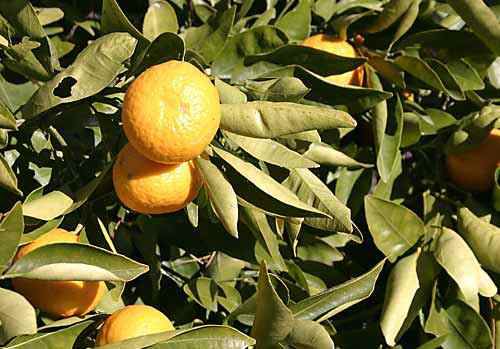
Tangelos, yesterday. Very tasty indeed.
In our high lime soil, this means not enough magnesium, so the first step was to apply liberal quantities of Epsom salts (magnesium sulfate). Then a general citrus fertiliser. I bought a bag of Yates finest, and set to applying the stuff. Then I read the label. "Use of this product may result in cadmium and mercury levels in fruit above permissible levels." What? I read it again. Apparently this fertiliser, specifically designed for citrus and fruit trees, which - and please correct me if I'm wrong - people normally grow because they want to eat the fruit, will eventually poison the fruit to the extent that we shouldn't be eating it! Can this be legal? Being realistic about this, I suspect that they have to put that statement on their product even though the risk of it actually happening is small, but even so, had I read the small print on the label on the shop, I would have bought another product. I shall cerrtainly use no more.
My father, bless his large cotton socks, suggested an organic alternative that involves citrus skins and copious quantities of human urine. I would welcome a more savoury alternative.
Next task: driving the tractor and cultivator round the truffière…
First entry in my first farm blog. I have a dim idea of what it will be about. There will be stuff about what's happening on the farm: pruning, planting, digging, truffle hunting, pressing or picking — whatever I happen to find interesting at the time. I may also wish to wax lyrical (first cliché - someone keep count, please) about the music I'm listening to or the books I'm reading, and if I'm not very careful, I may offer comments on local and world events. And pictures too. You can get all the background to who I am on the main Limestone Hills website (when it's finished), but for the time being consider me a middle-aged man with some minor (in my opinion) obsessions: fungi, music, books, writing.
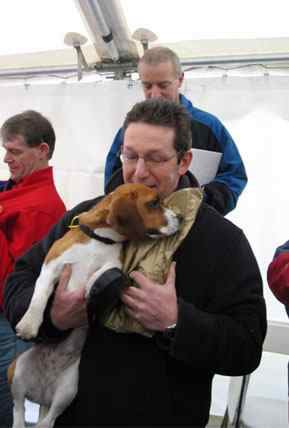
The author, with NZ champion truffle hound Peg.
From a work perspective, two big tasks confront me at the moment. As the placeholder page for Limestone Hills suggests, I am somewhat overdue with my next book. I need to put together enough uninterrupted hours to finish writing the thing - and current circumstances make that difficult. I'm with Neal Stephenson on the enabling factors for effective writing. "Writing novels is hard, and requires vast, unbroken slabs of time. Four quiet hours is a resource that I can put to good use. Two slabs of time, each two hours long, might add up to the same four hours, but are not nearly as productive as an unbroken four. If I know that I am going to be interrupted, I can't concentrate, and if I suspect that I might be interrupted, I can't do anything at all. Likewise, several consecutive days with four-hour time-slabs in them give me a stretch of time in which I can write a decent book chapter, but the same number of hours spread out across a few weeks, with interruptions in between them, are nearly useless."
I'm not writing novels, but the principle's the same. It takes an hour or two to get the bits and pieces of information for a particular section into my head (or refreshed, or in the right order), and then I can write for an hour or two. Then I can revise to my hearts content and go and do some farm work with a clear conscience. At the moment, this doesn't happen very often.
The farm work is more straightforward. We have "spring things" to do. The pruning of the olive grove, truffière and vineyard is finished, and it's time for some spraying to clean things up before we do the soil work around the truffle trees. This involves pulling a small set of sprung tines through the soil, loosening it and providing a nice soft tilth for the truffle fungus to grow through.
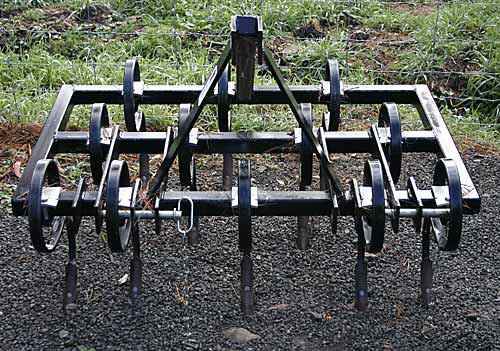
Interesting agricultural artefact number one.
Another significant task is repairing the irrigation system in the truffière, and renewing the drippers in the olive grove. There's some fencing to do, as well. And if normal spring temperatures are resumed in the next week or two, mowing grass will rapidly resume its tyranny.
.jpg)


